Member Blog: How to Hire a Fractional Cannabis CFO

Small businesses — from startup to $20 million — face challenges when it comes to hiring accounting and finance staff.
In addition to the budget-breaking cost of an in-house finance team, it’s not easy to find, train and manage the right people within the day-to-day of a growing business. Not to mention the fact that a full-time team likely wouldn’t have enough work to keep themselves busy with a business of that size. That’s why outsourcing has become popular across industries: small businesses can leverage the expertise of bookkeepers, tax preparers and planners, as well as CPAs and financial advisors, at a fraction of the cost.
The advisory role — often referred to as outsourced or fractional CFO services — fills a particularly essential need, providing business owners with a strategic partner to help make financial decisions about their short-, medium- and long-term future at a lower price-point than a full-time Chief Financial officer (which averages $229,000 per year not including vacations, bonuses and other benefits).
That’s why businesses between the $3-$20-million revenue mark consider outsourcing the position. Oftentimes these services include a la carte options such as taxes, accounting, payroll, and coding of transactions (essentially bookkeeping), depending on whether the business already has some of these functions in-house.
Three things to look for when hiring a cannabis CFO
There are a variety of ways to access outsourced or fractional financial services, whether it’s hiring an individual, using a freelance match-making service or working with a dedicated team.
- Do they provide forward-looking advice?Cannabis companies face unique challenges. Every business could benefit from cash flow forecasting, but in cannabis, where profits are extra tight, a CFO needs to be able to help strategic planning: weighing the cost-benefit of investments, strategizing to manage overhead and boost sales, and ensure the business stays disciplined as it grows.
- Are they involved in the industry?In an industry like cannabis, where regulatory shifts are always on the horizon, you want a CFO is staying on top of policy — both federal and local. That means they’ll have the necessary insight to help you plan with those changes in mind, as well as to think about what could happen as a result of all these shifts within your business.Beyond policy, a CFO should be able to help businesses with other industry-specific challenges, like securing merchant services for dispensaries and establishing banking relationships, which is significantly tougher for cannabis businesses to do, in light of current federal policy.
- Do they ask strategic questions?A good CFO never tells you what to do. They get to know your business through in-depth questions, identify the non-financial drivers to monitor and improve, and then help you navigate the best path with the information that you have.
When is it time to hire a fractional cannabis CFO?
If you find your business is getting to a point where you’re making decisions but don’t understand the financial impact or don’t know what risks may be out there — especially if you’re in a growth phase — hiring a fractional CFO will help guide you on the financial side and still fit within your budget.
The cannabis industry is at an inflection point. There are so many areas where strategic planning isn’t a nice-to-have, it’s a must-have. As regulations shift, it will be essential to have a financial partner who can help businesses pivot quickly and adopt new technologies that become available to the industry as we move forward with policy progress at the federal level.
Member Blog: The Entrepreneurial Operating System – Industry Agnostic

The EOS model was developed by Gino Wickman, an entrepreneur and author, based on his experiences working with small to medium-sized businesses. The system was introduced in the book “Traction: Get a Grip on Your Business”, written by Gino Wickman and published in 2007.
Today, EOS is utilized by a wide range of businesses across different industries, helping them establish a strong foundation for growth, enhance leadership effectiveness, and achieve greater overall success. The EOS framework’s practical approach and focus on accountability have contributed to its widespread adoption in the business world.
Diving into the six key components of the EOS (Entrepreneurial Operating System) model – Vision, People, Data, Issues, Process, and Traction – and discuss how strengthening the 6 components can increase team health, profitability as well as scalability in a business.
1. Vision:
Define a Clear Vision: Articulate a compelling and clear vision for the organization, involves identifying the core values, purpose, and long-term goals. Assisting in communicating this vision effectively to align everyone in the organization.
2. People:
Right People in the Right Seats: Assess whether the right individuals are in the right roles. Identify strengths and weaknesses, ensuring that each team member is aligned with their unique abilities.
Cultivate a Healthy Culture: This guide helps creating a positive and constructive workplace culture. This involves fostering open communication, trust, and accountability among team members.
3. Data:
Identify Key Metrics: Determine the critical metrics and data points that impact a business. Examples are financial indicators, customer satisfaction scores, or operational efficiency metrics.
Implement Data-Driven Decision-Making: Establishing a system for collecting and analyzing data regularly. Data-driven decision-making helps to enhance overall performance and adaptability.
4. Issues:
Create an Open Issues List: Develop a transparent issues list. This involves identifying and addressing challenges openly, ensuring that no critical issues are overlooked or ignored. Solving issues is an efficient way of bringing issues down to the ground and solving them forever.
Implement Structured Problem Solving: This is designed to be a guide to effective problem solving at the leadership level.
5. Process:
Document Core Processes: Documenting a handful of core processes ensures that everyone understands their roles and
responsibilities, fostering efficiency and reducing confusion.
Continuous Improvement: Encourage a mindset of continuous improvement.
6. Traction:
Set and Monitor Goals: Setting SMART goals (Specific, Measurable, Achievable, Relevant, Time-bound). Establishes a system for monitoring progress.
Implement Regular Accountability Meetings: Conducting regular accountability meetings to track progress, discuss
challenges, and ensure alignment with company objectives.
These tools are part of the EOS framework, which aims to help businesses, in any industry including the Cannabis Industry, become more organized, focused, and efficient in achieving their goals. Each tool serves a specific purpose within each of the 6 key components, contributing to the overall success of the organization.
How Compliant Tech Bolsters Cannabis License Application

Are you contemplating entering the burgeoning cannabis retail market? Whether you plan to open a dispensary in states that recently legalized recreational cannabis, like Maryland and New York, or any legacy states that are still awarding new licenses, the first and most crucial step towards success is ensuring that your cannabis retail license application meets all legal requirements. In this blog post, we’ll explore how compliant cannabis technology can be your guiding light and help you strengthen your license application, helping you navigate the intricate landscape of cannabis laws and regulations.
1. Grasping the Universal Elements in Licensing Requirements
The cannabis industry is a patchwork of regulations, with licensing requirements varying significantly from state to state. Yet, there are shared elements, such as legally binding sales limits, mandatory reporting to government agencies, and indispensable seed-to-sale cannabis product tracking. These commonalities are crucial, and you lay a strong foundation for your journey by understanding and adhering to them. Partnering with a reputed cannabis technology provider and using advanced cannabis software that automates all these requirements at your dispensary will demonstrate your commitment to compliance.
2. Mastering Cannabis Inventory Management
Effective cannabis inventory management is not just the key to your business’s success, it is also the linchpin to obtaining your cannabis retail license. Demonstrating proficiency in this area, including how you will accurately track and report inventory to your jurisdiction, is vital for compliance and regulatory adherence. With the help of the right cannabis inventory management system integrated into your cannabis POS, you can easily corroborate cannabis inventory requirements in your license application.
3. Ready-to-implement Tech Solutions for Key Challenges
If your chosen cannabis software provider provides multiple solutions, you can tackle the following essential aspects of your license application:
- Cannabis POS Requirements: The right cannabis POS solution significantly reduces human errors and ensures precise product tracking. Incorporating it into your business shows your dedication to accurate compliance.
- Automation for Compliance: Utilizing automated technology to oversee compliance matters, like reporting, purchase limits, and operational hours, underscores your commitment to regulatory conformity.
- Local Tracking System Interface: Crafting a strategy for seamless interaction with the local state/provincial tracking system is imperative. This demonstrates your readiness to operate within the regulatory framework.
- Peak Days Support: How the cannabis retail software you choose will support the busiest cannabis retail days of the year is an essential consideration. Being prepared for high-demand periods is a mark of a well-prepared dispensary business.
- Customer Privacy & Data Protection: Developing a plan for safeguarding customer privacy and proprietary information at your dispensary establishment is critical for responsible and secure operation. With the right software, your customer data will always be secure, and your dispensary will remain compliant.
- Multi-Location Inventory: For those with aspirations of business expansion, overseeing inventory across multiple locations is a strategy that can demonstrate your readiness for growth. This is where advanced cannabis software becomes even more crucial.
4. Tailored to Your State’s Regulatory Concerns
Cannabis technology can be customized to address the specific regulatory concerns of your state. Having technology that is adaptable to the nuances of your region is a key asset. This technology is your ultimate companion in navigating the complexities of regulations, helping you successfully secure your legal dispensary license and become a part of this rapidly growing industry. To ensure that your license application meets all dispensary tech and compliance requirements, download Cova’s Free Handbook, which is a great resource to help you submit a successful cannabis retail license application in your state.
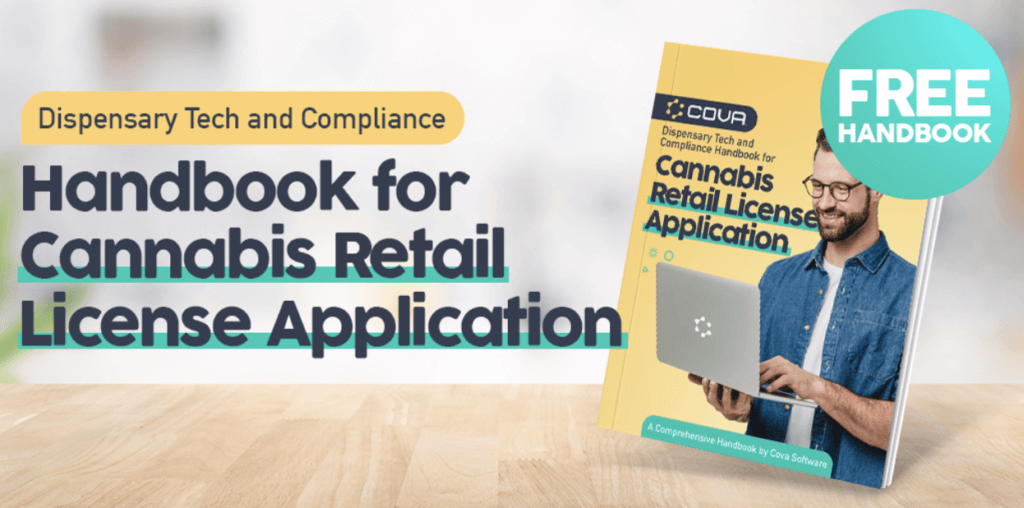
Unveiling Cultivation Secrets for a Record-Breaking Cannabis Yield
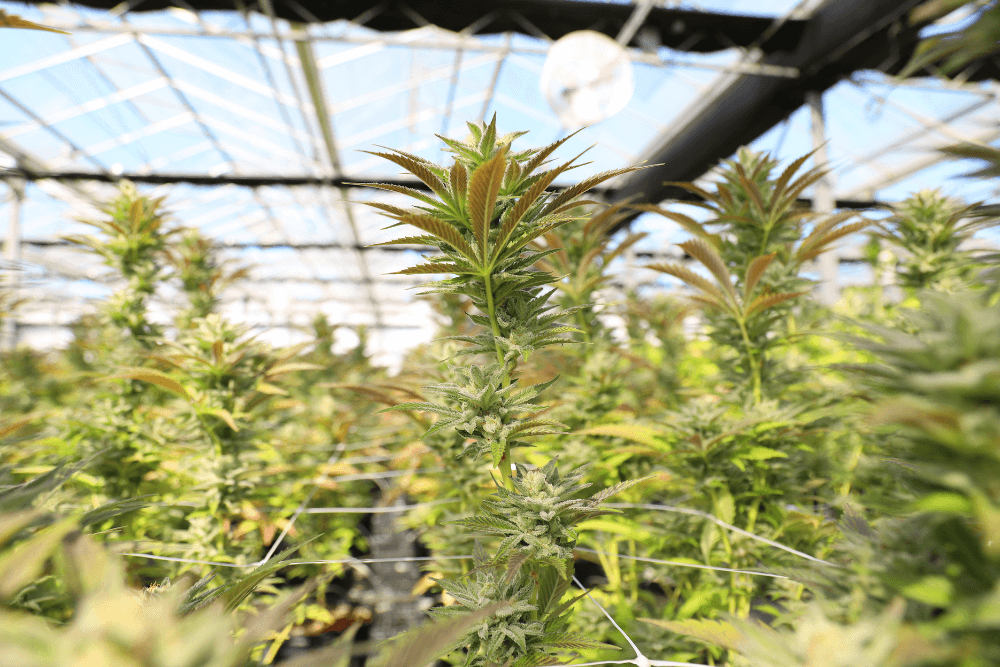
If numbers could talk, they’d tell an incredible story of the rise of cannabis. Now crowned the sixth most valuable crop in the United States, its growth trajectory is nothing short of remarkable.
To paint a clearer picture, in fresh insights from the second annual harvest report by Leafly, we learn that 2022 saw 2,834 metric tons of adult-use cannabis being grown across 15 legal cannabis states. What’s even more astounding is the growth – a 24% increase from the previous year, adding 554 more metric tons to the tally.
Are you reading this because you want to grow more cannabis, too? You’re in the right spot. Here, we’ll disclose the secrets to help boost your cultivation. Let’s begin!
Picking the Right Seeds
Your yield’s potential is, in many ways, determined by the seeds of the plant you’re growing. That’s why it’s important to understand different types of cannabis seeds and what they offer.
Firstly, there are feminized seeds, which are bred specifically to eliminate male chromosomes. This increases the chances of growing a female plant, which is crucial because only female cannabis plants produce the coveted buds you need. According to professionals, choosing feminized seeds means less guesswork and more yield potential.
| One popular feminized seed is the Do Si Dos strain, renowned for its potency and vibrant trichome-rich flowers. It offers a blend of physical tranquility and sensory elevation, making it a favorite among medicinal and recreational users. |
Then, we have auto-flowering seeds. These seeds automatically shift from the vegetative phase to the flowering phase based on age rather than light cycles. They’re great for beginners or those looking for a quicker harvest, as they mature faster than regular seeds.
Finally, there are the regular seeds. These seeds can be both male and female, so growers need to be careful during the vegetative stage to identify and separate male plants, ensuring they don’t pollinate the females.
Pro Tip: It’s essential to source your seeds from reputable sellers. Established seed banks or suppliers often provide detailed information about genetics, expected yield, and growth patterns, ensuring you make an informed choice.
Choosing the Best Soil Mixtures
Cannabis, by nature, prefers soil that is well-aerated and has good drainage capabilities. This ensures that the roots can breathe and access water without the risk of rotting.
For this purpose, you can create a soil mix combining coco coir, perlite, and organic compost. Coco coir will promote root health; perlite ensures proper aeration and organic compost offers essential nutrients for healthy growth.
It’s noteworthy that every strain might have its preferences. Therefore, it’s worth spending time researching and possibly even experimenting with small batches. It will ensure only a limited number of plants are affected (if something goes wrong) and provide clearer insights into what works best for specific strains or under certain conditions.
Ultimately, the right soil mixture will create the difference between a mediocre and a record-breaking yield.
The “Screen of Green” (SCROG) Method
The “Screen of Green” method is not just another cultivation fad; it’s a tried-and-tested method to enhance plant growth and optimize yields. It involves setting a horizontal mesh or net above your plants.
As the plants grow, their branches are gently woven into the screen, allowing for better light exposure and distribution. This promotes even and robust growth as even the lower branches receive adequate light.
But that’s not all! The method also allows plants to utilize space more efficiently. By training the plants to grow horizontally rather than vertically, growers can maximize their canopy space, resulting in more buds and, ultimately, a heftier harvest.
So, if you have limited growing space or are aiming for a stealthy indoor grow, SCROG offers a practical solution. Give it a try and see the results yourself!
Understanding the N-P-K Ratio
The N-P-K ratio is a simple yet crucial gardening component, especially for cannabis cultivation. “N-P-K” stands for Nitrogen (N), Phosphorus (P), and Potassium (K) – the three vital nutrients that plants need to thrive. Let’s dig into the details:
- Nitrogen (N) is fundamental for vegetative growth. It’s responsible for the lush green leaves you see on plants. For cannabis, especially during its vegetative phase, a higher nitrogen level ensures hearty growth.
- Phosphorus (P) plays a pivotal role in root development and flowering. It’s essential when cannabis plants transition to their blooming phase, as it encourages the growth of dense and resin-rich buds.
- Potassium (K) is a kind of all-rounder. It aids in overall plant health, ensures better protection from diseases, and boosts cell structure.
By tailoring this ratio to the plant’s growth stage, you can ensure your plants get precisely what they need and when they need it.
Recognizing Signs of Plant Disease
You’ve acquired premium seeds, perfected your soil mixture, and nailed the ideal N-P-K ratio. But, if you fail to protect your plants from disease, it’s all for nothing.
Diseases can stealthily undermine all your hard work, often taking hold before you even spot them. To avoid this situation, early detection is your best defense, saving both your crop and effort.
So, pay close attention to your plants’ leaves; are they discolored, yellow, or spotty? These could be distress signals sent out due to nutrient imbalances or invasive fungal attacks. Wilting leaves can point towards problematic roots, while unusual spots or mold hint at pest infestations or bacterial onslaughts.
Even a sudden, odd odor from your plant shouldn’t be ignored. Stay alert to these signs, as prompt recognition and action could be your harvest’s lifesaver.
The Best Time to Harvest
When it comes to yielding the most potent and abundant cannabis crop, timing is everything. If you harvest too early, you might miss out on maximum potency. On the other hand, if you are too late, you risk THC degradation.
To ensure you’re hitting that sweet spot, keep an eye on the trichomes – those tiny, mushroom-like glands on your buds. When a majority turn milky white with some amber, it’s usually prime time. Apart from this, monitor the pistils: if they’re more than 70% brown or red, your plant is signaling readiness.
Final Words
Growing a top-notch cannabis plant isn’t just about luck. It’s about knowing what to do and when to do it. So, save this handy guide and refer to it when you wish to grow cannabis. Also, make sure to keep learning, as the more knowledge you get, the better quality plants you can harvest.
Member Blog: Where Is Delta-8 THC Legal and Where Is It Banned? CBD Oracle’s Map Has the Answers
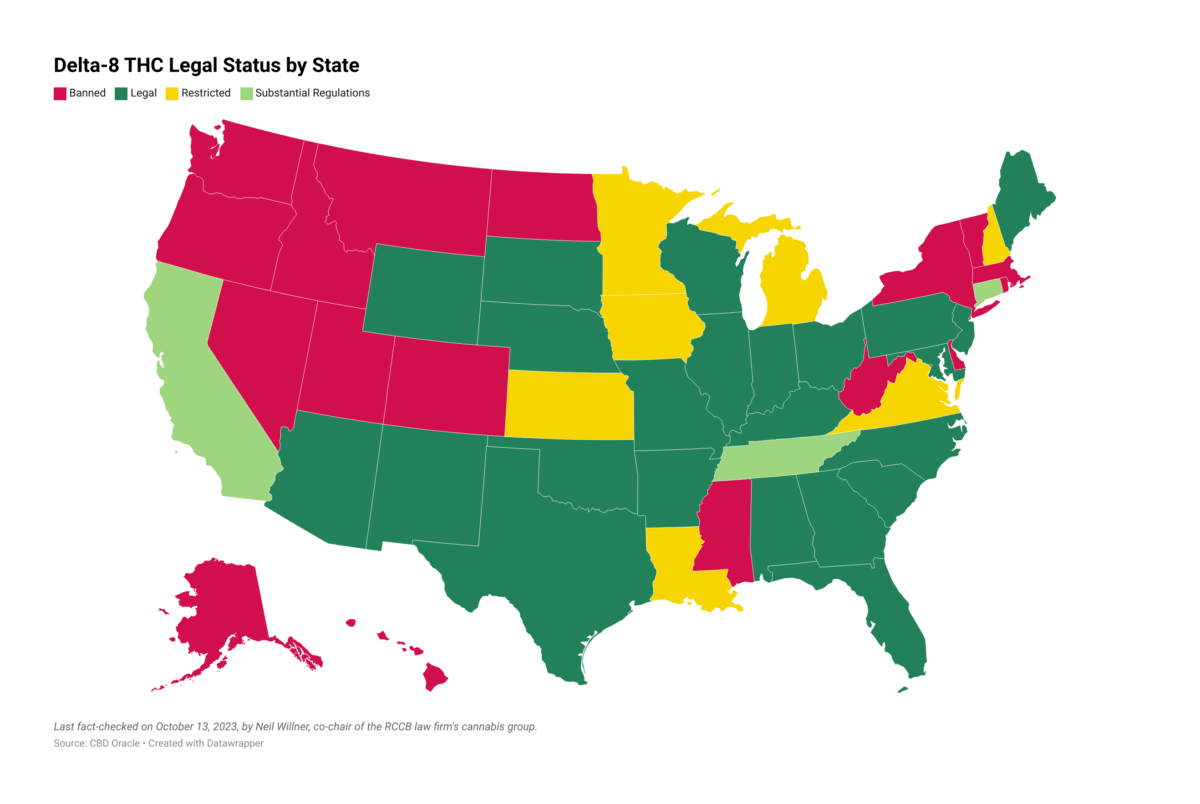
Delta-8 THC is probably the most controversial cannabinoid on the planet right now. With the 2018 Farm Bill being widely considered to have removed the THC isomer from the federal list of controlled substances, hemp and CBD companies quickly found a use for their excess CBD isolate. But if you’re considering selling delta-8 THC, federal law is only a part of the picture, and at state level, you have a patchwork of different laws and regulatory schemes to contend with.
This is why CBD Oracle, working alongside Neil Willner co-chair of the Cannabis Group at Royer Cooper Cohen Braunfeld, has produced a state-by-state map of delta-8 THC’s legality based on extensive reviews of state law. If you want to know what’s going on with delta-8 THC in a specific state, this is one of the best resources around to get the answer you’re looking for.
Delta-8 THC Is Legal in 22 States and 1 District With Limited Regulation
Despite the controversy surrounding delta-8 THC, it remains legal in 22 states and 1 district, with only limited regulation. This covers the following states:
- Alabama*
- Arizona
- Arkansas
- Florida*
- Georgia (?)
- Illinois
- Indiana (?)
- Kentucky*
- Maine
- Maryland* (?)
- Missouri
- Nebraska
- New Jersey
- New Mexico
- North Carolina
- Ohio
- Oklahoma
- Pennsylvania (?)
- South Carolina (?)
- Texas (?)
- Washington D.C.
- Wisconsin
- Wyoming*
Here, a * beside the state’s name means they’ve instituted age restrictions, preventing anybody aged 21 or under from buying delta-8 THC. States marked with (?) are currently involved in legal action about the status of delta-8 THC.
In the majority of these cases, state law basically follows the blueprint laid down by the 2018 Farm Bill with few or no additional rules. In fact, only a handful of states (Alabama, Florida, Kentucky, Maryland and Wyoming) have even passed laws preventing youth from buying delta-8 THC.
Legal actions are ongoing in several states, with the situation being slightly different in each. For instance, in Maryland, the hemp industry won a temporary injunction against the state, preventing the state from enforcing the provisions of House Bill (HB) 556 which relate to hemp until the action is resolved. The bill originally made it so that delta-8 THC products (and most CBD) could only be sold in licensed marijuana dispensaries, but this was deemed by the court to create a monopoly.
Delta-8 THC Is Banned in 17 States and Severely Restricted in 7 More
For every state where delta-8 THC is de facto legal, there is another state which has either banned or severely restricted the cannabinoid. In total, CBD Oracle’s analysis shows that delta-8 THC is banned in 17 states and severely restricted in 7 more. The states with bans are:
- Alaska
- Colorado
- Delaware
- Hawaii
- Idaho
- Massachusetts
- Mississippi
- Montana
- Nevada (technically could be approved for marijuana industry)
- New York (isomerization banned, could theoretically be sold in adult use)
- North Dakota
- Oregon
- Rhode Island
- Utah (possible in medical industry)
- Vermont
- Washington
- West Virginia
And there are severe restrictions – limiting all THCs to be under 0.3% for hemp products, unless otherwise noted – in the following seven states:
- Iowa
- Kansas
- Louisiana (all THCs must be under 8 mg per serving and 1% by dry weight)
- Michigan (all THCs under 0.3% and only marijuana-derived delta-8 allowed)
- Minnesota (all THCs under 0.3% and less than 5 mg per serving)
- New Hampshire
- Virginia (2 mg serving limit or >25:1 CBD:THC ratio)
Exactly how delta-8 THC is banned or restricted varies by state. For instance, while Colorado bans the “isomerization” process used to make delta-8 from CBD, Idaho basically bans anything that contains THC at all, even if it’s just CBD with trace, federally-acceptable levels of delta-9 THC. For the restricted states, most require that all THCs total to under 0.3% by dry weight, which is technically possible for a delta-8 THC product to meet, but essentially none do.
The analysis also revealed that – just like with marijuana – making delta-8 THC illegal doesn’t automatically remove it from a community. In Hawaii and Mississippi, for instance, despite state law banning delta-8 THC, it is still openly sold.
Only Three States Have Substantial Regulations on Delta-8 THC
In California, Connecticut and Tennessee, delta-8 THC is legal but has substantial regulations in place. In California and Connecticut, delta-8 THC is treated as marijuana and is sold as part of the adult use industry. This automatically institutes a wide range of requirements on the cannabinoid, including rules on testing and labeling to ensure safety and transparency for consumers.
Tennessee is the unique case here, where delta-8 THC is regulated as a “hemp-derived cannabinoid” and is legal to sell to adults aged 21 and over. Senate Bill (SB) 378 includes requirements for testing for contaminants, informative labeling and marketing which does not target youths, as well as a 25 mg serving size limit.
The Patchwork of Laws and the Future of Delta-8 THC
The key take-away for sellers of delta-8 THC is that current state regulations are a patchwork, making it very difficult to navigate for even the most responsible of companies. The product you can sell in Arizona without issues is probably not legal in Kansas, and would require batch testing and more to be sold in Tennessee.
This uncertainty may be resolved by the upcoming 2023 Farm Bill, but even this isn’t a sure thing. While the 2018 Farm Bill opened the door to a whole host of products and simply assumed (incorrectly) that the FDA would step up to regulate finished products, the new version might offer the clarity that was lacking. However, it’s just as likely that the bill will redefine “hemp” in a way that excludes delta-8 THC by default.
Pretty much the only thing you can depend on is that you’ll need to keep a close eye on state laws in the coming year. CBD Oracle’s map will be continuously revised to reflect the current legal reality and help responsible hemp companies remain compliant.
______________________________________________________________________________________
Lee Johnson is the senior editor at CBD Oracle, and has been covering science, vaping and cannabis for over a decade. He focuses on research-driven deep dives into topics ranging from medical uses for CBD to industry and user statistics, as well as general guides and explainers for consumers.
CBD Oracle is a cannabis consumer research company working to improve the safety and transparency of cannabis and hemp products, which publishes in-depth scientific, legal and consumer analyses on cannabis and cannabinoids.
Committee Blog: Leveraging Business AI Tools for Scaling Cannabis Companies – Strategies and Implementation

Produced by: NCIA’s Retail Committee
Introduction
The cannabis industry has experienced remarkable growth in recent years, as both regulatory landscapes and public perceptions shift. As the market expands, cannabis companies face increasing pressure to scale their operations while maintaining compliance and meeting customer demands. In this era of digital transformation, Business AI tools, such as ChatGPT, offer innovative solutions that can empower cannabis companies to streamline processes, enhance customer experiences, and drive growth. A tremendous benefit is it takes little skill to learn how to use AI for a beginner or one could work with an expert in AI. In this article, we will explore the potential of AI tools in the cannabis industry and delve into strategies for their effective implementation to achieve desirable business outcomes.
The Power of Business AI Tools in the Cannabis Industry
Artificial Intelligence (AI) is transforming various industries, and the cannabis sector is no exception. Business AI tools encompass a range of technologies, including natural language processing (NLP), machine learning (ML), and data analytics, all of which can be harnessed to address the unique challenges faced by cannabis companies seeking to scale.
- Enhanced Customer Engagement: One of the critical aspects of scaling any business is effective customer engagement. AI-powered chatbots, like ChatGPT, can provide personalized, round-the-clock support to customers, addressing inquiries, guiding purchasing decisions, and even providing product recommendations. These chatbots create a seamless and responsive customer experience, fostering loyalty and increasing sales.
- Data-Driven Insights: AI tools can analyze vast amounts of data to extract valuable insights that can inform strategic decisions. For cannabis companies, this could mean analyzing customer preferences, tracking market trends, reviewing internal operations management, and optimizing supply chain management. These insights enable businesses to adapt quickly to changing market dynamics and stay ahead of competitors.
- Process Automation: Tedious and time-consuming tasks can hinder scalability. AI-powered automation can optimize inventory management, order processing, and regulatory compliance, allowing employees to focus on higher-value activities. This not only increases efficiency but also reduces the risk of errors.
- Predictive Analytics: Predicting demand and optimizing production are crucial for scaling operations. AI can analyze historical data to forecast market demand, ensuring that companies can maintain sufficient inventory levels and avoid overstocking or shortages.
- Regulatory Compliance: Navigating the complex and ever-changing landscape of cannabis regulations is a significant challenge. AI can assist in monitoring compliance by cross-referencing business practices against current regulations, minimizing the risk of legal issues.
Implementation Strategies for Business AI Tools
While the potential benefits of AI tools are clear, effective implementation is key to realizing those benefits. Here are some strategies for cannabis companies to consider when integrating AI technologies into their operations:
- Identify Pain Points and Goals: Begin by identifying the specific pain points your cannabis company faces in its scaling efforts. Whether it’s customer service bottlenecks, inventory management challenges, or regulatory compliance hurdles, pinpointing these issues will guide your AI implementation strategy.
- Certified Professionals and Agencies: Collaborating with certified AI professionals or agencies that specialize in your industry can provide invaluable expertise. These experts can assess your business requirements, recommend suitable AI tools, and tailor solutions to your unique needs. Their experience ensures a smoother and more effective implementation process.
- Data Collection and Preparation: AI thrives on data, so ensuring clean, accurate, and comprehensive data is crucial. Collaborate with your AI partner to define data requirements, gather relevant information, and organize it for analysis. This step forms the foundation for accurate predictions and insights.
- Customization and Training: Generic AI models can be a starting point, but tailoring these models to your cannabis business is essential. Work with your AI professionals to fine-tune algorithms, customize chatbot responses, and train the system to recognize industry-specific nuances.
- Continuous Monitoring and Improvement: Implementing AI tools is not a one-time task. Continuously monitor AI performance, gather feedback from customers and employees, and refine your AI systems accordingly. This iterative process ensures that your AI tools evolve with your business needs.
- Change Management and Training: Introducing AI into your company may require employees to adapt to new processes. Effective change management, including training programs and clear communication, can help employees embrace AI technologies and use them to their full potential.
Desirable Outcomes and Future Considerations
The successful implementation of Business AI tools can yield a multitude of desirable outcomes for cannabis companies:
- Scalability: By automating processes and optimizing operations, cannabis businesses can scale their production, distribution, and customer base more efficiently.
- Improved Customer Experiences: AI-powered chatbots provide prompt and personalized customer service, enhancing the overall experience and fostering brand loyalty.
- Data-Driven Decision-Making: AI-driven insights enable data-backed decisions, reducing uncertainty and enabling proactive responses to market changes.
- Regulatory Adherence: AI tools can help ensure compliance with evolving cannabis regulations, minimizing legal risks and potential setbacks.
- Innovation and Competitive Edge: Embracing AI technologies positions cannabis companies as forward-thinking, innovative players in the industry, setting them apart from competitors.
As the cannabis industry continues to evolve, it’s important to consider potential future developments and challenges. These may include:
- Ethical Considerations: As AI becomes more integrated into business operations, it’s important to address ethical concerns surrounding data privacy, transparency, and bias.
- Regulatory Changes: The cannabis industry’s regulatory landscape is dynamic. AI tools must adapt to new rules and compliance requirements, requiring ongoing monitoring and adjustments.
- Advanced AI Capabilities: AI technology is advancing rapidly. Cannabis companies should stay informed about emerging AI tools and consider how they can further enhance business operations.
Conclusion
In the ever-expanding cannabis industry, the integration of Business AI tools holds immense potential for companies aiming to scale their operations and achieve sustainable growth. From enhancing customer engagement to optimizing processes and predicting market trends, AI technologies like ChatGPT offer tangible benefits that can drive innovation and success. By partnering with certified professionals or agencies and following effective implementation strategies, cannabis businesses can navigate the complexities of AI adoption and position themselves as industry leaders. As the industry evolves, a thoughtful and strategic approach to AI implementation will be essential for cannabis companies looking to thrive in a competitive market.
Committee Blog: Navigating Cannabis Insurance – 10 Essential Insights for Buyers

Produced by: NCIA’s Risk Management & Insurance Committee
Contributing Authors: Stephanie Bozzuto, Cannabis Connect Insurance, Acrisure Partner | Merril Gilbert, Trace Trust | Shay Aaron Gilmore, The Law Office of Shay Aaron Gilmore | Matthew Johnson, AssuredPartners
Navigating the labyrinth of insurance coverage can be daunting for any business owner, especially within the emerging cannabis industry. Questions like “What coverage do I need?” and “How do I ensure my policy covers my exposures?” are common and crucial. The National Cannabis Industry Association’s Risk Management & Insurance Committee is here to guide cannabis business operators in protecting both personal and business assets.
Below are ten key insights and considerations to guide you when purchasing your next insurance policy. Whether you have a policy in place or are exploring multiple policies, it’s crucial to ensure they align with your intended coverage.
-
Understanding Policy Forms, Endorsements, and Exclusions
Policy forms, endorsements, and exclusions are pivotal during a claim. For instance, some policies sold to cannabis companies in the US have outright ‘cannabis business exclusions’. It’s crucial to read and understand these documents to avoid jeopardizing your business.
-
Compliance with Protective Safeguards
To ensure theft coverage response in a loss, understand and comply with the protective safeguards on your property insurance policy. For example, non-compliance with a Central Station Alarm Warranty can exclude coverage after a robbery.
-
Landlord Insurance Requirements
Understand the insurance coverage required by your landlord before signing any contract. If a triple net lease is required, you, as the lessee, will need to insure not only your business but also the building, which can be costly.
-
Local Insurance Requirements
Each city, state, and county permitting cannabis will have its own insurance requirements, often including general liability, product liability, commercial auto insurance, and workers’ compensation.
Some states have created specific requirements not present in other states (looking at you, Michigan!). Consult with an attorney to fully understand and meet these requirements.
-
Facility Maintenance
Maintain and update your facilities, especially if they are older than 20 years, to avoid limited property coverage and being forced to buy an “actual cash value” policy versus “replacement cost.” Updates to your HVAC, plumbing, roofing, and electrical systems are well worth the investment.
-
High-Risk Area Considerations
If your facility is in a high brush area, be prepared for limited property insurance options and a list of exclusions due to tighter wildfire insurance availability. Your insurer may offer expanded coverage if you’re willing to invest in wildfire defense systems.
-
Evaluating Insurance Companies
Know the financial strength of your insurance company before purchasing. Consider whether the company is admitted or non-admitted and research their reputation and claims experience.
-
Claims Experience
Inquire about the carrier’s claims handling experience, conditions of coverage, and the duration it takes to receive a payout from a covered loss. If your broker doesn’t have claims experience with a given carrier, feel free to ask someone on the NCIA’s Risk Management & Insurance Committee.
-
Legal Concepts and Types of Insurance
Understand the legal concepts involved in property and liability insurance and familiarize yourself with the different types of property insurance policies available on the market. For instance – are you purchasing an admitted or a non-admitted insurance policy? Are you on an ‘all risk’ or a ‘named perils’ coverage form?
-
Grasping Liability Insurance Distinctions
Liability insurance is crucial, acting as “third-party” coverage, contrasting with “first-party” coverage like property insurance, which protects against damage to one’s own assets.
- Duty to Defend vs. Duty to Indemnify
- Understanding the difference between the duty to defend and the duty to indemnify is vital. The former is broader, obligating the insurer to defend the insured in lawsuits, even if allegations are baseless. The latter only kicks in if the insured is found legally liable for damages.
- Defense Inside/Outside the Limits
- One should also inquire about defense inside versus defense outside the limits of a liability policy. A policy with ‘defense outside’ considers all legal costs separate from the total liability coverage, while legal fees will erode the total liability limit for a ‘defense inside’ policy.
- Insurable Interest
- An insured must have a direct financial interest in the preservation of the property and be exposed to monetary loss as an immediate and proximate result of its destruction. The interest must not be contingent or expectant. Interest in anything not founded on an actual right to the property is uninsurable.
- Scope and Importance in Cannabis Industry
- The scope of liability insurance, covering legal costs and payouts, is essential, especially in the cannabis industry, where legal landscapes and associated risks are continuously evolving. Adequate coverage is paramount to mitigate potential financial losses due to unique legal challenges and risks, such as product liability claims.
Conclusion
The world of business insurance, especially in the cannabis sector, can be quite complex. However, with the insights provided here, you can navigate your policy purchasing process with confidence and ensure your business is fortified against potential risks. By understanding policy forms, adhering to safeguards, and adapting to local regulations, you can lay a resilient foundation for your business’s growth and success.
The proactive approach advocated by the National Cannabis Industry Association’s Risk Management committee emphasizes the importance of informed decision-making. By evaluating an insurer’s claims experience, comprehending legal nuances, and staying attuned to industry developments, you can empower your business with robust protection, ensuring a resilient foundation for growth and success.
Committee Blog: Cannabis Cultivation Facilities vs. Cannabis Retail Facilities – Disparities and Economic Impact

Published by NCIA’s Cannabis Cultivation Committee (CCC)
The cannabis industry has experienced a significant transformation in recent years, with the legalization and decriminalization of cannabis in many regions around the world. This shift has led to the emergence of two distinct yet interconnected sectors within the cannabis market: cultivation facilities and retail facilities. While both play a vital role in the cannabis supply chain, they exhibit notable disparities that have a substantial impact on the economy.
Cultivation Facilities: Nurturing the Green
Cannabis cultivation facilities are the backbone of the industry, responsible for the growth and cultivation of the cannabis plant. These facilities are typically large-scale operations that require advanced horticultural techniques, specialized equipment, and a controlled environment to ensure the optimal growth of cannabis plants. Cultivators must navigate various factors such as lighting, temperature, humidity, and nutrient levels to produce high-quality yields.
One of the most significant disparities between cultivation and retail facilities lies in their resource requirements. Cultivation facilities demand substantial capital investment for equipment, real estate, utilities, and staffing. High-quality lighting systems, advanced climate control mechanisms, and nutrient delivery systems contribute to the significant start-up costs associated with these facilities.
Beyond the financial aspect, cultivation facilities often face regulatory challenges. Licensing requirements, zoning restrictions, and compliance with state and local regulations add another layer of complexity to their operations. However, despite these challenges, cultivation facilities have a direct impact on job creation, local economies, and tax revenues. They provide employment opportunities in rural and urban areas alike, stimulating economic growth and revitalization.
Retail Facilities: The Consumer Experience
On the other end of the cannabis supply chain are retail facilities, where consumers can purchase various cannabis products, including flowers, edibles, concentrates, and topicals. Retail facilities offer a diverse range of products to cater to the preferences and needs of consumers, enhancing the overall cannabis experience. These establishments range from dispensaries to specialized stores and require a different set of considerations compared to cultivation facilities.
Unlike cultivation facilities, retail establishments tend to have lower start-up costs. However, they face their own unique challenges. Navigating a complex web of regulations regarding product labeling, packaging, and sales is crucial for compliance and consumer safety. Retail facilities must also provide a safe and welcoming environment for customers while ensuring age restrictions are strictly enforced.
Retail facilities play a pivotal role in shaping public perception and acceptance of cannabis. As these establishments become more mainstream, they contribute to the normalization of cannabis use and promote responsible consumption practices. This normalization, in turn, has implications for the broader economy.
Economic Impact: Cultivation vs. Retail
The economic impact of cannabis cultivation facilities and retail facilities extends far beyond the cannabis industry itself. Both sectors contribute to job creation, tax revenues, and local economic development. cultivation facilities often require a larger workforce due to the labor-intensive nature of plant cultivation and processing. These jobs span across various skill levels, from horticulturists and technicians to administrators and security personnel.
Retail facilities, while generally employing fewer people per establishment, create job opportunities in customer service, retail management, and education about cannabis products. Moreover, both cultivation and retail facilities contribute to the local economy through real estate demand, leasing agreements, and utilities consumption.
From a taxation perspective, both sectors generate significant revenue for local and state governments. Cultivation facilities are subject to cultivation taxes and other regulatory fees, contributing to state coffers. Retail facilities, in addition to sales taxes, often face excise taxes on cannabis products. These revenues can then be channeled towards public services, education, infrastructure, and social programs.
It’s All Economics
Having more cultivation facilities and fewer retail facilities can have detrimental effects on economic stability. The balance between suppliers and retailers plays a crucial role in maintaining a healthy economy, and an excessive skew towards either end can lead to negative consequences as we are realizing in the current economic state.
A robust economy thrives on competition, which drives innovation, efficiency, and lower prices for consumers. When there are an excessive number of suppliers combined with fewer retailers, this can create challenges in distribution and logistics. Retailers act as intermediaries between suppliers and consumers, helping to streamline the flow of products and information. When there are fewer retailers, distribution networks can become strained, causing delays, inefficiencies, and potential shortages.
Economic stability relies on a balanced employment landscape. An overabundance of suppliers with limited retailers may lead to job losses in the retail sector, affecting consumer spending and the overall labor market. This can create ripple effects across various industries and reduce the purchasing power of consumers, ultimately slowing down economic growth.
Moreover, concentration of power among a few suppliers can lead to monopolistic tendencies, stifling competition and limiting consumer choice. Monopolies can dictate prices, control supply, and hinder market dynamics, negatively impacting economic stability.
Closing Thoughts
The disparities between cannabis cultivation facilities and retail facilities highlight the intricacies of the evolving cannabis landscape. While cultivation facilities require substantial investments in equipment and compliance, retail establishments focus on creating a positive consumer experience and normalizing cannabis use. Together, they form a symbiotic relationship that drives economic growth, job creation, and tax revenues.
As the cannabis industry continues to mature, it is crucial for stakeholders, policymakers, and entrepreneurs to recognize the importance of both cultivation and retail facilities. Striking a balance between these sectors will be vital for achieving a sustainable and prosperous cannabis market that benefits not only those directly involved in the industry but also the broader economy and society at large.
Member Blog: Novel Foods Applications Stalled?

The UK CBD market had an estimated value of £300 million in 2020 and by the end of 2022 estimates had doubled that figure. This goes to show that CBD being deemed a “novel” food in January 2019 has had little impact on market growth and if predictions are right will exceed £1 billion by 2025. With the FSA’s March 2021 deadline long behind us and having made submissions by the deadline, many companies will be feeling comfortable. However, it’s worth remembering that the authorization process is still on-going, so while products that are part of a validated application are allowed to remain on the market they are still not authorized as novel foods. And now with the FSA conducting market research to aid in their risk assessment of consumer CBD products, some concerning data has been published.
The FSA commissioned Fera Science Ltd to carry out a survey to obtain a brief overview of current CBD products on sale in England and Wales in order to help FSA’s risk assessment of CBD products. The products selected covered, oils, sprays and edibles (including drinks). The study collected various data on the products. This included testing for CBD content, cannabinoid profiles, heavy metals, pesticides, residual solvents, Polycyclic Aromatic Hydrocarbons (PAHs) & mycotoxins. A summary of the results are shown below:
- Heavy metals (cadmium, mercury & lead) and arsenic were not detected in the majority of samples, meaning levels were below the limits of quantification of the method. Seven samples contained lead, four samples arsenic and two samples contained cadmium. Mercury was not found in any sample. A definitive statement as to whether products exceed maximum levels cannot be made due to uncertainty as to whether products would be classified as a food (i.e. oil) or a food supplement.
- A low incidence of low levels of mycotoxins, with Fusarium mycotoxins found more frequently than aflatoxins and ochratoxin A, mostly at the methods reporting limit. Three samples were found to contain ochratoxin A at the methods reporting limit.
- A total of seven pesticide residues were found across all of the products (each product was tested for over 400 pesticides). There are no specific Maximum Residue Limits (MRL) for CBD products.
- One oil product was found to have PAHs above the regulated levels, if classed as a product for direct consumption. If classed as a food supplement the PAHs were within regulated levels.
- Three samples contained residual solvents. One product was over the MRL.
- Most products contained CBD close to the declared value. Two oils had substantially different levels than that declared (one higher and one lower). CBD was not detected in one of the drink products. These are potentially non-compliant with compositional and standards requirements.
- Delta 9-THC was detected in 87 % (26) of the samples analysed. Of these 40% (12) were found to have THC+ (the total sum of illicit cannabinoids in the product) above the 1mg threshold.
Although Fera only tested a small number of products, the fact that such a large percentage of products were found to have issues is concerning to say the least. It throws into question how many other products currently on the market that are part of a validated NF application, but aren’t up to spec.
The next question is, are you 100% sure that your current market offerings meet their product specifications? If not then there’s no time like the present to take a closer look at your products and their manufacturing process. It’s also important to remember that if you do need to make changes then these changes need to be updated in your current regulatory filings.
If you would like to discuss this further, please reach out to us at info@arcuscompliance.com.
Member Blog: Unleashing the Green Revolution – Empowering Cash Management in the Cannabis Industry with Automated Bliss

For most cannabis business owners, the abundance of cash poses a never-ending cash management challenge. Owners, staff and financial teams must navigate the complexities of managing and securing large cash volumes with limited access to banking relationships due to the federally illegal status of cannabis. Most dispensaries resort to manual cash handling and counting, however, every time cash is counted manually – typically around six times a day – dispensaries face the risk of miscounts, theft and security threats as well as challenges in tracking volumes, reporting changes and supporting audits.
Handling cash manually is inefficient and unsustainable for new and established dispensaries. Forward-thinking cannabis retailers are turning to automation solutions that transform the collection, counting and reconciliation of cash volumes in a retail setting. Cash automation offers a solid, systemic alternative to the typical cash handling processes.
One medical dispensary in D.C. incorporated cash automation to help with the time-consuming manual counts and to improve productivity. This dispensary, the largest and oldest in Washington, D.C., accounts for 54% of the cannabis sales in the city and accepts multiple payment methods. Cash comprises 40% of sales and is a major pain point for the dispensary’s managers and associates.
Since implementing cash automation solutions last year, the dispensary has improved count accuracy, reduced discrepancies and saved time for its staff, who now can service the 400 – 900 patients who visit each day instead of counting cash for hours on end. Additionally, automation has been a game changer for the dispensary’s accounting team. The finance team can view the exact volume of cash on hand remotely and in-store, informing important business decisions for cash planning, including leveraging available cash on hand for product and services payments and optimizing change order and deposit schedules to reduce armored security and bank costs. Real-time reporting and visibility empower the finance teams to manage cash operations with confidence.
Other benefits include:
- User-friendly dashboard with cash flow visibility integrated with accounting software.
- Notifications on urgent needs, including hardware performance issues, deposit capacity and placing change orders.
- Easy, mobile access to cash balances and transaction history across multiple locations.
- Customizable reporting capabilities for auditing, vendor-specific transactions and overall analysis of every transaction by user/payee, amount and date.
- Security measures to ensure efficient cash counting, balancing to POS and securing cash with high-speed recyclers.
With automation capabilities, cannabis businesses can focus on operational efficiencies, bolster inventory management and systemically ensuring process compliance instead of the time-consuming counts that typically overwhelm employees. As the cannabis industry continues to evolve and expand in 2023 and beyond, embracing cash automation allows dispensaries to thrive while reducing costs and labor and maintaining control over their cash ecosystem.
Member Blog: 5 Things You Need to Do Before You Launch Your Cannabusiness in New York

Cannabis was legalized in New York in 2021, and now the market is starting to fully open up for all types of cannabusinesses across the state. Despite a rocky start to rolling out new licenses, it’s almost time for the general public to dip their toes in and start their own dispensaries.
New York’s legal cannabis market is projected to be worth $4.2 billion by 2027, making it the country’s second-largest recreational cannabis state. It won’t be long before cannabis businesses have hundreds of locations across New York.
Curious about how to open a New York dispensary? Here are five things you need to do to get ready for your blossoming cannabusiness.
Conduct Market Research & Choose a Location
Since many cannabusinesses will be opening up in New York in the next few years, you need to ensure that yours is set up for success from the start. The best way to secure success is by selecting a high-demand area with minimal competition. You can identify lucrative locations by exploring different neighborhoods and conducting market research.
Visit prospective spots in person, instead of just looking at them on a map. You’ll get a much better sense of the feel of the area, the type of people walking through, the surrounding businesses, and more. And if feasible, talking to residents and local business owners will help you to really understand the market.
It is also important to be mindful of the New York zoning laws before securing a location. According to statewide zoning restrictions, a cannabis dispensary can’t be on the same road or within 500 feet of a school and 200 feet from a house of worship. Cities may have additional restrictions to limit the number of cannabis dispensaries in a certain location. Do your research before you get married to a location that won’t work out for logistical reasons.
Apply for a License
You’ll need a license to open a cannabusiness in the state of New York. However, as of October 2023, the path to applying and receiving a cannabis license in the state is a little up in the air.
When applications for the first licenses opened up, New York legislators wanted to ensure that people who were negatively impacted by the state’s previous criminalization of cannabis could apply first. This included people who were convicted of a cannabis offense in New York or were affected by a loved one’s conviction.
Now, starting on October 4, 2023, New York will start accepting license applications from a much broader pool of entrepreneurs. Applications are open to everyone over the age of 21 who does not already have three licenses. This is exciting news for many aspiring cannabusiness owners who were not eligible the first time around.
However, these licenses may not be issued as soon as prospective owners hope. When the state legalized cannabis, its goal was to award half of the retail licenses to people with previous cannabis convictions, racial minorities, women, and veterans disabled during service. Several veterans have filed a lawsuit stating that veterans were unfairly passed over for the early licenses. The judge in the case ordered that the state wait to award any new dispensary licenses until the case continues.
Keep an eye on the New York Office of Cannabis Management’s website for updates on the next round of licensing applications.
Secure Funding for Your Cannabusiness
Opening a dispensary in New York will be expensive. While profits will likely be high once you open, you need to find a way to secure the funding needed to get your cannabusiness operational — which experts say could cost between $500,000 to $2 million.
This figure accounts for a variety of expenses for your cannabusiness, including:
- Licensing and application fees
- Lawyers and consultants
- Real estate
- Dispensary design and construction
- Staffing
- Business equipment
- Surveillance and security system
- Marketing and advertising
- Products and inventory
Many cannabis entrepreneurs take out loans to cover these up-front costs, either from credit unions or cannabis-friendly banks. Some are able to partner with others or enlist investors to start their businesses. However, you should do your due diligence and research before taking on a loan or going into business with an investor. Unfortunately, there has been some predatory lending occurring in the market because of the inability to lend from large banks. Make sure that you do this research before you get too far in the process of creating your cannabusiness.
Understand Cannabis Laws & Regulations in New York
There are hundreds of laws and regulations that apply to cannabusinesses in New York. While this can feel overwhelming, it’s important to follow them carefully, especially when you’re setting up your dispensary.
There are some regulations that apply to your customers that you’ll need to adhere to, including:
- Customers must be over the age of 21
- Customers can only buy 3 ounces of cannabis flower per day
- Customers can only buy 24 grams of cannabis concentrates per day
Others regulations apply to your business location, including:
- Installing a 24-hour commercial-grade security system
- Installing a perimeter alarm
- Conducting video surveillance in every part of the store with cannabis products
- Products cannot be visible from outside of the store
- Maintaining minimum staffing levels (depends on business plan submitted with application)
- Training staff on local ordinances, laws, and cannabis safety
It’s vital to take these rules seriously from the beginning. Neglecting even a single law could result in your dispensary getting shut down. You can consult an extensive overview of the New York cannabis laws and regulations here.
Invest in the Right Team
You need to hire a team of high-quality employees who will help your business succeed from the very first day. Your budtenders can make or break your entire business model, so you need to vet them carefully and train them well.
Your budtenders will be interacting directly with clients. They’ll answer their questions, suggest products, and upsell items. Hire these employees carefully, and make sure they’re happy in their positions by offering great pay and benefits.
To streamline training, create training manuals and SOPs (standard operating procedures) so that every employee is trained in the same way. This will limit mistakes and increase efficiency and customer satisfaction.
Final Thoughts on Launching Your New York Cannabusiness
Cannabis is expected to become a booming industry in New York. If you’ve always dreamed of opening a cannabusiness, now’s your chance to get in as early as possible and make your impact on the market!
SAFER Banking Act Clears Senate Committee

NCIA (and myself personally!) have been talking about the SAFE Banking Act for years.
After the Senate Banking Committee’s hearing on the topic of financial services and the cannabis industry in May, it became clear that in order for the bill to continue on in the legislative process and receive a markup that changes to a few sections needed to be made.
As a result, a slightly new (and improved?) version of the bill was introduced as the SAFER (S. 2860: Secure and Fair Enforcement Regulation) Banking Act last month. Most of the changes in the bill pertained to Section 10, which bars federal banking regulators from taking discriminatory enforcement action against any industry (not just cannabis).
Once SAFER was formally introduced, the Senate Banking Committee announced that a markup was scheduled for September 27. It’s important to note that this was the first time ever that a Senate committee held a markup on a pro-cannabis bill.
During the markup session, multiple amendments were offered. The first, offered by Chairman Brown (D-OH) was what’s known as a “manager’s amendment” and primarily made technical changes to the bill. That amendment also made changes so that the Treasury secretary would be given one year (instead of 180 days) to issue updated guidance to financial institutions that work with cannabis businesses that was first released during the Obama administration in 2014. It also stipulated that federal home loan banks are now included under a list of financial institutions that would be protected from being penalized by federal regulators simply for working with state-legal cannabis businesses.
Another amendment, from Sen. Warnock (D-GA) would have created a 5-year sunset for the legislation unless a report from the Treasury Department certified that it had decreased the racial wealth gap and ameliorated other negative economic impacts of the war on drugs. This amendment ultimately failed.
Additionally, amendments from Senators Hagerty (R-TN), Rounds (R-SD), Crapo (R-ID) were also offered but were ruled out of order, withdrawn, and failed, respectively.
Republican members of the committee voiced concern that the bill allowed for financial institutes to utilize reputational risk to de-bank certain accounts they do not align with ideologically and argued that no financial regulator should be able to pressure any financial entity to refuse to provide service to a lawful entity.
Some Democrat members, particularly Sen. Warnock (D-GA), voiced concern that the bill does not adequately address the disproportionate impacts of marijuana criminalization and its exacerbation of the racial wealth gap in the United States. Other members of the committee encouraged amendments and future legislation intended to improve the quality of life for those most negatively impacted by marijuana criminalization in addition to creating safer conditions for banks and other financial institutions. Sen. Warnock was the lone Democrat who voted “No” on the bill during the markup.
Ultimately, the bill passed out of the committee markup by a bipartisan vote of 14-9. This sets the stage for a full Senate floor vote, which Majority Leader Schumer (D-NY) has committed to scheduling as soon as possible, with the possibility of adding the HOPE and GRAM Acts to the bill before passage.
I don’t know about you, but I’m not done making history yet! Stay tuned for the latest on the SAFER Banking Act and how you can help get the bill passed!
Committee Blog: Production of Cannabis Infused Products – A Guide to Optimal Facility Design and Workflow

Published by NCIA’s Facilities Design Committee
The burgeoning cannabis industry continues to grow and diversify. One sector that’s seen significant expansion is cannabis-infused food production. In this industry, meticulous facility design is crucial to ensure product quality, worker safety, and regulatory compliance.
This article discusses key design considerations for creating an efficient, safe, and regulation-compliant cannabis food production facility.
Begin with the End in Mind
This may seem more philosophical than operational but adopting this mindset early in your design process can help you avoid common pitfalls that seem to plague even experienced cannabis professionals. So, what does it mean to “begin with the end in mind?” It simply means that you need to define a lot of aspects of your business before you begin design. A very simple example of this is: What product(s) do you want to produce in this facility?
This might seem like a simple question, but there is tremendous complexity lurking just below the surface. While a commercial kitchen in a facility such as a restaurant might be a very flexible space allowing for the production of multiple products using the same space and equipment, food manufacturing of shelf-stable products requires a bit more specificity. Let’s pick a single product as an example: Gummies. Here are a few questions and decision points that need to be addressed before diving into design specifics:
- Do you have a recipe for your gummies?
- Does your recipe require specific equipment for production? Does that equipment require ventilation (i.e., a hood)?
- Have you set throughput and volume targets for production (i.e., how many gummies do you want to produce per hour/day/month, etc.?)
- How will your product be packaged?
- Will more than one type of product be produced in this same room/area?
- If so, how do you plan to mitigate cross-contamination risks?
- Have you defined a facility workflow that maps a product’s process from component parts (ingredients) to processing to packaging to storage and delivery?
This is a very incomplete list but demonstrates the fact that a simple product decision comes with a multitude of related decisions that must be made to successfully implement the production process. For example, your decision on your facilities throughput goals directly impacts your equipment choices. Are you doing artisanal, hand-crafted gummies in small batches or are you producing gummies at scale for maximum throughput?
Do you plan to start with one product and eventually expand to other products? Knowing this in advance allows you to strategically plan for those potential line-extensions. The design of an area in your facility to produce one kind of product does not necessarily effectively translate to the production of a different product. The equipment, space-planning, and process-planning for the production of gummy products is very different from the production of baked edibles or chocolate edibles for example. Knowing what you ultimately want to do can help you strategically design for the future and avoid potentially costly retrofits. There is no “one-size-fits-all” cannabis kitchen design.
Another important consideration is the development of Standard Operating Procedures (SOPs). SOPs are a key component of developing Good Manufacturing Processes (GMP) which is becoming increasingly critical to manufacturing in the cannabis industry. Understanding and documenting how things should be done will give you key insights into what is needed in your overall facility design.
This mindset of working backwards from your goal can be applied to almost every aspect of your operation. This includes things such as labor schedules, purchasing guides, order scheduling, storage, packaging, delivery and more. Define your goals and outputs and then work backward from there.
Space Planning
The first crucial consideration is space planning. It is imperative to account for all operational aspects of the facility, from storage and production to packing and shipping. Ensuring there is adequate space for these activities contributes to the workflow efficiency and helps maintain a safe work environment.
Storage areas should be designed to accommodate raw materials, finished products, and waste materials separately. Temperature-controlled areas may be necessary for perishable ingredients or to maintain product stability.
Production areas need sufficient space to house specialized equipment for cannabis food production. These can include extraction machines, distillation other laboratory equipment, infusion systems, and commercial kitchen appliances for food preparation. The areas should also facilitate the movement of employees and materials.
Packing and shipping areas need to accommodate packing materials, finished product cases, and space for shipping operations. Depending on your scale, this may include room for pallets, forklifts, or other necessary equipment.
Workflow Design
An optimized workflow is critical for efficiency and safety. The design of the facility should facilitate a streamlined flow of materials from receiving to shipping. This ‘one-way’ flow can help prevent cross-contamination and reduce movement of personnel and materials.
Special consideration should be given to the workflow around extraction and infusion processes. These are complex and sensitive steps that involve precise control over temperature and pressure. The facilities should be designed to allow for these activities to be conducted safely and efficiently.
Equipment Planning
When planning for equipment, several considerations come into play. Firstly, understanding the power requirements for the extraction, infusion, and food production equipment is paramount. Adequate electrical infrastructure needs to be installed to meet these demands.
Drainage is another critical consideration. Extraction processes can produce significant waste that needs to be safely disposed of. Furthermore, commercial kitchen operations require a professional-grade drainage system.
Lastly, space must be set aside for regular equipment maintenance and potential upgrades. The rapid pace of innovation in the cannabis industry means equipment can quickly become outdated and need replacement.
Food Safety Best Practices
As a food production facility, following best practices for food safety is a must. This includes implementing Hazard Analysis and Critical Control Points (HACCP) plans to identify potential hazards and establish procedures to mitigate them.
Facilities must ensure appropriate hygiene measures, including handwashing stations and employee changing areas. Special attention should be given to allergen management, considering the diversity of ingredients that could be used in cannabis-infused foods.
Proper ventilation is a key factor in maintaining air quality and controlling odors, which can be a significant issue in cannabis production facilities. An effective ventilation system will also help control humidity, which can impact both the quality of the product and the longevity of the equipment.
Putting It All Together
The design of a cannabis food production facility is a complex task requiring a clear understanding of the production process, equipment requirements, safety considerations, and regulatory compliance. Through thoughtful planning and design, producers can build a facility that not only meets these demands but is also flexible enough to adapt to the ever-changing landscape of the cannabis industry.
Member Blog: Effective Ways to Build a Buzz Around Your Cannabis Business

The cannabis industry is more than just sprouting; it’s flourishing at an incredible pace.
According to the U.S. Cannabis Report: 2020-2021 Industry Outlook, annual legal sales (covering both medical and adult use) are projected to increase at a CAGR of 21%. By the year 2025, the market is expected to be worth a staggering $50 billion, up from $13.2 billion in 2019.
As a matter of fact, these numbers are not just statistics on a page; they present a golden opportunity for entrepreneurs in the cannabis sector.
But let’s be clear: tapping into this booming market is no walk in the park. The competition now is fierce (more than ever). That’s why, as a cannabis business owner, you need to focus on marketing or, more specifically, buzz-building.
Now the question is: How can you ignite interest and keep the conversation going around your cannabis business? Continue reading this article to get the answer!
Optimize Your Website and SEO
Your website is like your online storefront; it’s often the first place people go to learn about your business. When you have a well-designed and easy-to-navigate website, it can turn curious visitors into loyal customers.
But what’s the use of a great website if no one can find it? That’s where SEO, or Search Engine Optimization, comes in. When your target audience looks for products or services related to yours, SEO will help your website show up in search engine results.
Two Simple SEO Strategies to Implement:
- Keyword Research: Find out what words or phrases people use to search for cannabis products like yours. Once you’ve identified these keywords, include them naturally in your website’s content, titles, and meta descriptions.
- Local SEO: If you have a physical store or primarily serve a specific area, make sure to include location-based keywords. For example, if you’re based in Denver, use phrases like “Denver cannabis store” or “best cannabis in Denver” in your website content and meta tags.
These strategies will give you a kick-start by improving your website’s visibility and attracting more customers.
Play with Coupon and Promo Codes
Everyone loves a good deal, and your target customers are no different. Offering discounts, coupons, and promo codes is a quick and simple way to get them talking about your business. It ideally has two benefits:
- It makes your products more appealing.
- It encourages first-time buyers to give your brand a shot.
To make this strategy even more effective, you can consider submitting your coupon to websites like 420CouponCodes.com and tap into their existing audience. It gives a direct channel to potential customers (who are already interested in products like yours) to connect with your brand. It’s like fishing where the fish are already biting!
Moreover, once your customers start using these codes, they will likely share them with friends and family, naturally building buzz around your business.
Leverage Customer Reviews
There’s no denying that in the cannabis industry, word-of-mouth can make or break any business. So, you must encourage your customers to leave reviews about your products and their experience with your brand. If there’s an issue you’re unaware of, a customer review can bring it to your attention so you can fix it.
But that’s not all. Most people check online reviews before making a buying decision; they want to know what others think before they take the plunge. Platforms like 420 Friendly™ are emerging as valuable resources for this purpose. It allows users to leave comments, rankings, ratings, and recommendations about various businesses in the cannabis sector.
By encouraging such reviews, you show your customers you care about their feedback. This, in turn, builds trust among them and boosts the brand’s goodwill.
Develop a Strong Brand Identity
Brand identity is like the face and personality of your business; it’s what customers see and feel when they interact with you. But do you know that it goes beyond just having a catchy name and a cool logo? It should represent the value you hold, the quality of your products, and the kind of experience you want your customers to have. Let’s take an example to understand this better.
Suppose your cannabis business specializes in organic, locally sourced products. In that case, your branding could include earthy colors and natural images to convey a sense of wellness and sustainability. A catchy slogan like “Grown Local, Felt Global” could further emphasize your business’s focus on quality and community.
This way, when people come across your product, they instantly know what you stand for and why they should choose you over competitors.
Tip: Conduct a brand audit before you even start the branding process. It will help you answer key questions like:
- What are the strengths and weaknesses of your current branding?
- What do your potential customers value most in a cannabis brand?
- What do your competitors do well, and where do they fall short?
Don’t Neglect Geotargetting
Finally, if you’re keen on making a splash in the cannabis industry, you can’t afford to overlook geotargeting. This simply means focusing your marketing efforts on a specific local area or community. But why does it matter?
Well, laws and regulations for cannabis differ from place to place. What works in one location might not be applicable in another. Plus, local customers love supporting businesses in their community.
There’s another reason you should focus on geotargeting. According to a study conducted by Localiq, approximately 40% of baby boomers go to a dispensary because it’s near their home or work. So, if you focus on geotargeting, you attract the locals and increase your sales.
Moreover, it’ll allow you to tailor your promotions, advertisements, and even your products to better suit the needs and tastes of the local crowd. And that’s definitely the wise step to becoming the go-to spot for the community.
Summing It All Up
These are a few ways in which you can build a buzz for your cannabis business. But it’s worth stating that it’s an ongoing process. So, you must create the right mix of branding, social media engagement, influencer collaborations, community outreach, and a robust online presence. This way, you can stand out from the crowd and make your brand a household name.
Committee Blog: International GxP Considerations When Cultivating Cannabis – Part 1
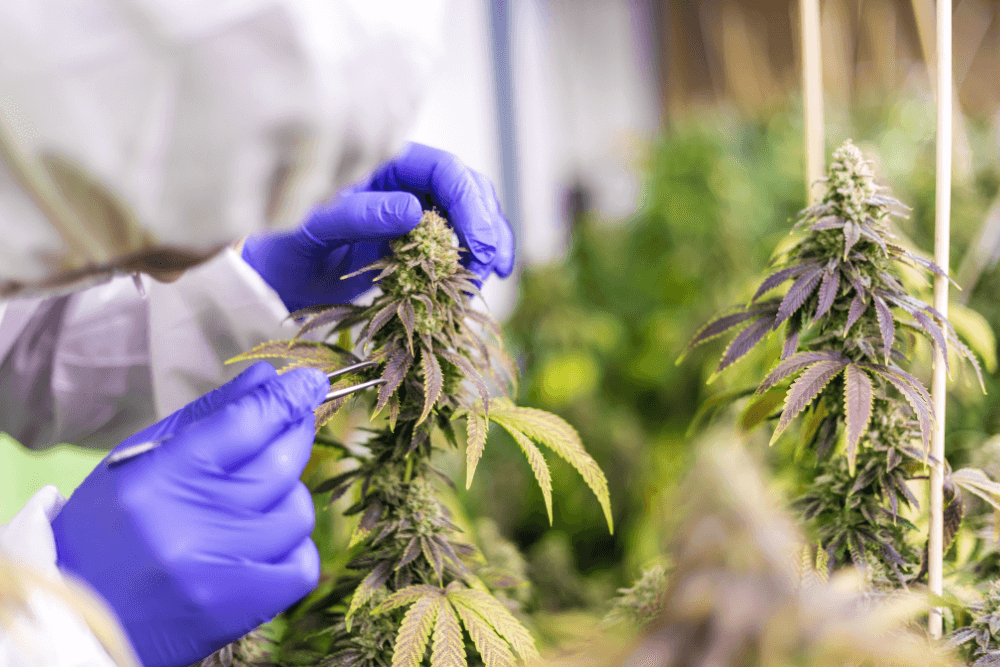
Published by NCIA’s Facilities Design Committee
As the global cannabis industry continues to expand, the importance of international GxP standards becomes increasingly vital. GxP is an umbrella term used to describe the various forms of compliance/standards available: GMP, GACP, GMCCP (Bedrocan), etc. While GMP is typically associated with the manufacturing of pharmaceuticals and other consumer products, it can also be applied to plant cultivation (GACP). These guidelines were developed by the World Health Organization (WHO) in 2003; they help ensure the quality, safety, and consistency of products, fostering consumer trust and facilitating international trade. In this blog post, we will explore the key considerations and requirements for cultivating cannabis in accordance with international GxP standards, allowing cultivators to meet the stringent regulatory expectations across borders.
GMP vs. GACP: What’s the difference?
First, it is important to explain the difference between GMP and GACP: GMP (Good Manufacturing Practice) is a set of quality management and manufacturing guidelines and regulations that ensure pharmaceutical, food, and medical device products are consistently produced and controlled according to quality standards. It aims to minimize risks involved in production and ensures the safety, efficacy, and quality of the final product. GACP (Good Agricultural and Collection Practices) is a set of guidelines and principles used in the cultivation and harvesting of medicinal and aromatic plants. It ensures that the plants are grown, collected, and processed in a manner that maintains their quality and prevents contamination, ultimately ensuring the safety and effectiveness of herbal products derived from these plants.
GxP Best Practices for Cannabis Facilities
Generally speaking, GACP applies to the “cultivation zone” and is less expensive to implement; GMP standards should be used in all “post-harvest zones” and is considered pharmaceutical grade. Below you will find a set of considerations and best practices used in most compliant cannabis facilities.
- Compliance with Regional Regulations: Before embarking on cannabis cultivation, it is essential to understand and comply with the specific regulations governing cannabis production in a specific region. Different countries have varying laws and requirements surrounding cannabis cultivation/export, including licensing, permitted cultivation methods, quality control, and product labeling. Familiarize yourself with the applicable regulations (in the country you intend to cultivate in and the country you intend to supply) to ensure full compliance with international GxP standards. Then organize a meeting (pre-audit) with your local audit provider (e.g. ASTM) to develop a proper gameplan.
- Facility Design and Maintenance: A crucial aspect of GxP compliance is having a well-designed cultivation facility that prioritizes cleanliness, efficiency, and product integrity. Considerations include proper airflow and cannabis specific HVACD systems (e.g. InSpire.ag or Ceres GH Solutions), dedicated cultivation and processing areas, appropriate lighting, appropriate drying space, automation and adequate pest control measures. Maintaining a clean and organized facility with strict hygiene protocols is essential for preventing contamination and ensuring the quality of the final cannabis products. Water quality, flexible cultivation integration, and sustainability should be top priority when in the design phase of your project.
- Crop Management System (CMS): Incorporating an all-inclusive CMS into your agricultural practices brings numerous benefits to crop monitoring and management. Real-time data collection, remote monitoring, disease detection, true seed-to-sale tracking, employee workflow tracking, certificate of growth analysis, predictive analytics, automated irrigation (based on real time plant weight), and historical data analysis collectively enhance a cultivator’s ability to monitor crop progress effectively. By making informed decisions based on accurate data and insights, cultivators can optimize crop growth, increase productivity, and promote sustainable farming practices. Embracing a good CMS (e.g. WeightSense Adapt), while leveraging the power of a Building Management System (BMS) is undoubtedly the best step forward towards advanced compliance, safer product and higher consistency/quality.
- Seed and Genetics: Selecting high-quality seeds or clones with desirable traits is vital for successful cannabis cultivation. When sourcing genetics internationally, it is crucial to consider the origin and reputation of the supplier. Ensure that the genetics comply with regional regulations and are free from pests, diseases, and genetic abnormalities. Match phenotypes with your specific environment to naturally defend against some of these risks. Proper documentation and traceability of seed sources are essential for GxP compliance and product consistency. In-house tissue culture labs bring a host of complexity to your propagation department although provide true consistency and reduced disease if carried out properly.
- Cultivation Practices: GxP-compliant cultivation practices focus on ensuring consistency, purity, and traceability (e.g. CMS) throughout the cultivation process. Considerations include standardized cultivation techniques, such as appropriate nutrient management, integrated pest management (IPM), water quality control, and sanitation procedures. Documentation of cultivation activities, such as crop inputs, environmental conditions, and pest management interventions, is essential for traceability and quality control purposes. As an example, under-canopy lighting (e.g. Thrive Agritech) can help reduce pests, disease, and labor input, all while increasing your yield and product quality.
- Post Harvest Practices: GxP in post-harvest forms the cornerstone of ensuring the quality and safety of agricultural products after harvesting. These practices use a range of vital considerations, including stringent hygiene and sanitation protocols to prevent contamination, comprehensive worker training to uphold proper handling techniques, implementation of effective traceability systems for accountability, meticulous quality control measures for sorting and grading, and the maintenance of optimal storage conditions encompassing temperature and humidity control. The integration of pest and disease management strategies, robust packaging selection, documentation upkeep, and cross-contamination prevention further validate the post-harvest GMP framework. By focusing on these key principles, producers safeguard product integrity, enhance shelf life, and contribute to the overall safety of cannabis in the supply chain.
- Quality Control and Testing: International GxP standards emphasize robust quality control measures throughout the cultivation process. Implementing comprehensive testing protocols for cannabinoid potency, microbial contaminants, heavy metals, residual solvents, and pesticide residues is crucial. Regularly analyze samples from each batch to ensure compliance with international quality standards and regulatory requirements. Establishing relationships with accredited testing laboratories can aid in obtaining accurate and reliable test results. Consider SAP analysis and run-off testing if you would like to maximize your situational awareness and plant health.
- Documentation and Record Keeping: Accurate documentation and record-keeping are essential components of GxP compliance. Maintain detailed records of cultivation activities, including seed sourcing, cultivation inputs, environmental conditions, pest management, testing results, and batch-specific information via proper SOP (standard operating procedures) development. These records serve as evidence of adherence to GxP standards and facilitate regulatory inspections, product recalls, and traceability in the event of any issues. Most importantly, they help cultivators maintain a safe and stable facility.
- Additional Considerations Include: Worker training, regulated plant-tracking system, inventory control, storage conditions, packaging, handling and cross-contamination practice, waste management and continuous improvement.
In part two of this GxP blog, we explain the matrix between these interlocking subject matters and how/where they relate to GxP based on department (so keep a look out for part two).
GxP Standards: Bringing It All Together
Cultivating cannabis in accordance with international GxP standards is crucial for ensuring the quality, safety, and consistency of cannabis products across borders. Adhering to regional regulations, designing and maintaining a GxP-compliant facility, selecting high-quality genetics, implementing standardized cultivation practices, conducting rigorous testing, and maintaining comprehensive documentation are all integral to achieving international GxP compliance. And of course, engage a local GxP specialist with experience in the cannabis field to help navigate your team to success. By prioritizing these considerations, cultivators can position themselves for success in the global cannabis market while meeting the requirements of regulatory authorities and ensuring consumer confidence in their products. It’s time to be a part of the solution, and help break the stigma that comes with cannabis cultivation and manufacturing.
Member Blog: Management Science Associates, Inc. Leads Research Initiatives Alongside Vireo Health

Contributing Authors: Geoff Atkinson, Senior Data Analyst, Management Science Associates, Inc. | Madeline Grant, Business Development Manager, Management Science Associates, Inc. | Paloma Lehfeldt, Director of Medical Education, Vireo Health
One of the promising uses for medical cannabis is treating chronic pain, potentially reducing or replacing prescription opioids and thus reducing the number of overdoses and deaths. Due to the legal status of cannabis and its schedule 1 status on the Controlled Substance Act, there has not been a significant amount of clinical research into its efficacy as a replacement or adjunct therapy for opioids, or its optimal dosing. Unfortunately, due to the lack of research and data there remains uncertainty for patients’ access to pain management and relief through cannabis. The limited research and data availability create uncertainties around patients’ access to cannabis for pain relief. Considering this, Management Science Associates, Inc. (MSA) has taken the initiative to collaborate with cannabis operators such as Vireo Health, aiming to investigate the impact of cannabis consumption on patient health outcomes by utilizing real-world healthcare data. This empirical data is crucial for enhancing our understanding of the complexities surrounding cannabis usage.
MSA and Vireo Health Study
MSA partnered with Vireo Health of Minnesota to complete a first of its kind study for Minnesotan medical patients in the state’s programs. We focused on several hundred customers from eight Vireo dispensaries across Minnesota. Using MSA’s patented de-identification software the data reflected that customers of eight dispensaries in Minnesota reduced their legal opioid usage by an average of 30%. A comprehensive analysis illustrated that these customers, on average, consumed 115 mg of morphine equivalent (MME) per month to their initial cannabis purchase. During the period of cannabis consumption, this figure decreased to 80 MME/month, representing a significant 30% reduction. Notably, opioid prescriptions reverted to higher levels after customers completed their final cannabis purchase. While individual circumstances may necessitate specific medication usage, aggregating data over larger cohort allows for capturing overarching trends.
Once we established, in this particular data set, cannabis may aid in reducing opioid use, we examined additional contributing factors in more detail to determine which patients had the most success. Using MSA’s patented de-identification technology, an individual’s cannabis purchases was matched with their prescription records while maintaining the confidentiality of personal health information. Understanding the connection between cannabis purchasing trends and medical outcomes could be very valuable in making informed decisions about dosing and connecting customers to the products that most effectively meet their particular needs. With the limited clinical research in particular randomized control trials in the United States, there is not nearly as much of this kind of information available for cannabis as there is for more traditional pharmaceuticals. Studies like this are crucial to gather credible data for medical patients to purchase and consume the correct products and dosage.
Continued Results of the MSA and Vireo Health Study
One initial observation is that the impact of cannabis on opioid prescriptions is different for different age groups. Individuals under the age of 45 experienced a 47% decrease in opioid prescriptions, while the 45–64 age group saw an average drop of 35%. Those over the age of 65, who tended to have the highest amount of opioid prescriptions across all three time periods, saw no significant decrease during the time they were purchasing cannabis. There were small differences between men and women. Women used more prescription opioids overall but saw a slightly greater percentage decrease when they began purchasing cannabis.

These differences may be related to different demographic groups preferring different forms of cannabis. The table below shows several forms where there were significant differences in percentage of total cannabis spending by age or by gender. For example, younger customers spent more on vape cartridges, and males tended to spend more on flower.
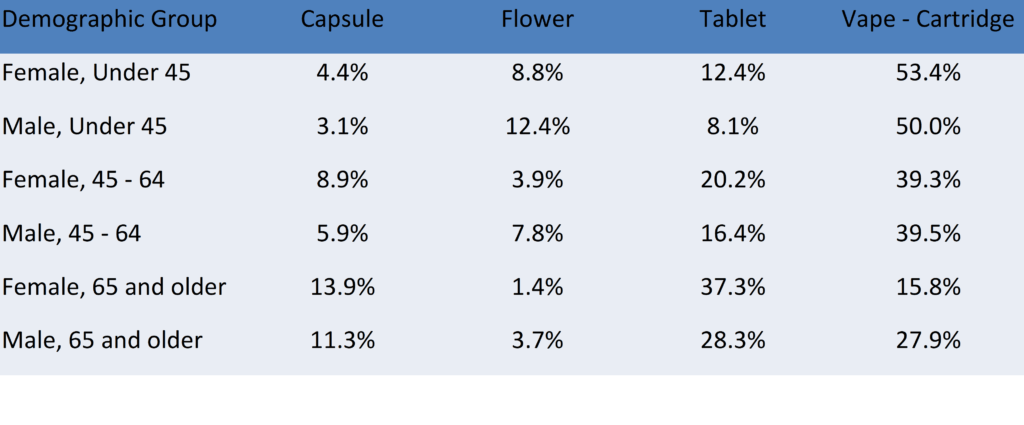
Interestingly, there appears to be no substantial correlation between the total amount of THC purchased and the successful decrease in opioid prescriptions. There was high variation between individuals, but the group of patients who succeeded in reducing their opioid prescriptions purchased an average of 418 mg of THC per month. Those who showed no decrease in opioid prescriptions purchased an average of 563 mg of THC per month. However, those who successfully reduced their opioids did show a preference for products with a high ratio of THC:CBD, spending over 70% of their cannabis budget on products with a ratio of 19:1 or higher.
We also examined the connection between different forms of cannabis and patients’ decrease in opioid prescriptions. One interesting way to divide patients is whether they focused on buying one form of cannabis or sampled many different products to find something that would benefit them. Patients who spent over 60% of their total cannabis budget on one form saw an average decrease of 16% in their opioid prescriptions. Patients who were less focused on one form saw an average decrease of 44%. A conflating factor in this analysis is that customers who purchased many different forms of cannabis also tend to have longer periods of cannabis usage. Customers who tried one or two forms of cannabis averaged 136 days between their first and last purchase. Customers who tried three or four forms of cannabis averaged 342 days. Customers who tried five or more forms of cannabis averaged 833 days.
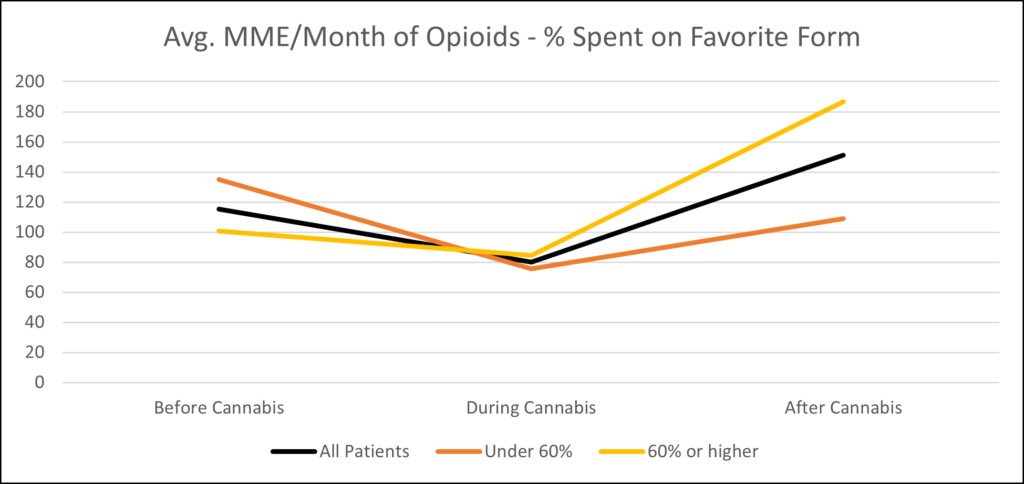
Another way to study the efficacy of particular forms of cannabis is to group patients by their preferred form. For example, customers who spent the majority of their cannabis budget on capsules saw a 63% reduction in opioids while those who preferred tablets saw a 34% decrease. Customers who purchased mostly vape products (the most popular form in these particular dispensaries) saw a 28% decrease, but less rebound towards earlier levels after they stopped purchasing cannabis. Some of these analyses are less statistically significant because of the relatively small number of customers in each group.
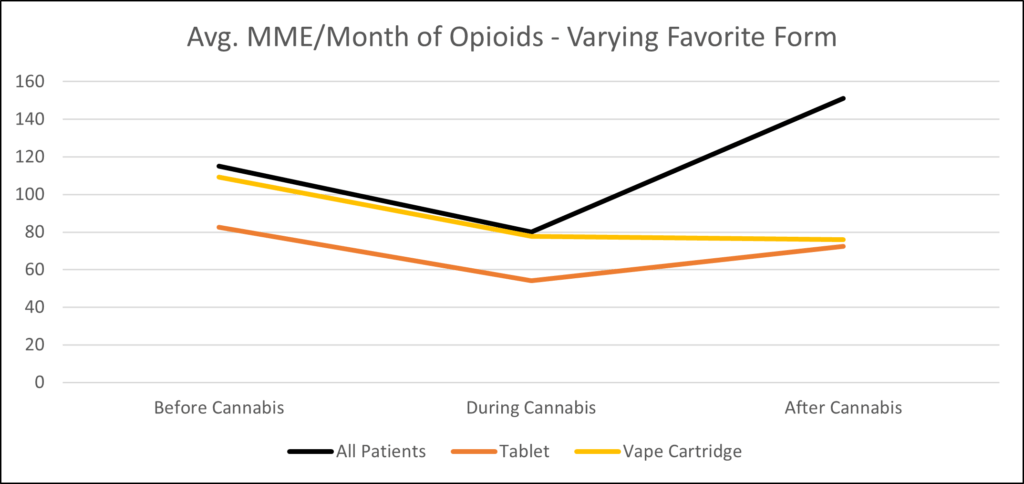
Next Steps
While these preliminary findings are intriguing, they underscore the necessity for further research. MSA will continue to look at cannabis customers across multiple states, where different types of products may be available, which might either reinforce our findings, or illuminate some interesting differences between customers in different markets. Looking at more total customers would increase the significance of the findings relating to customers’ preferred forms of cannabis, which would be very helpful in pointing future customers towards the products most likely to help them. MSA will continue to work with cannabis companies, healthcare professionals, advocates, and policymakers across the United States to conduct studies and continue to share reliable data with the cannabis industry.
If you are interested in learning more or getting involved with MSA by being a prominent leader in medical cannabis research, we’d love to hear from you. You can reach out to Madeline Grant at mgrant@msa.com to schedule an introductory call.
Member Blog: The Importance of PCI Compliance for Cannabis Payments at a Dispensary

The cannabis industry has witnessed exponential growth recently, with legalizations sweeping across various states. The demand for cannabis products is soaring, prompting dispensaries and retailers to explore the convenience of digital payment solutions to meet customer preferences. However, in this rapidly evolving landscape, compliance with industry regulations is paramount, especially when processing cannabis payments securely. This blog post delves into the significance of PCI compliance for dispensary payments, highlighting the potential penalties for non-compliance and the need for a fully compliant cannabis payment processing solution.

The Booming Cannabis Market and the Rise of Digital Payments
The growing cannabis market has paved the way for cannabis retailers and dispensaries to embrace digital payment options to cater to their customers’ convenience and preferences. As more consumers seek cashless and contactless payment methods, integrating digital payments into dispensary operations has become essential. However, the dynamic nature of the cannabis industry requires strict adherence to security and compliance standards.
Understanding Cannabis PCI Compliance and its Significance
PCI DSS (Payment Card Industry Data Security Standard) is a set of security standards designed to protect cardholder data during payment processing. Compliance with PCI DSS is mandatory for all organizations that accept, process, store, or transmit credit card information. In the cannabis industry, where the risk of fraud and cyber threats is high and consumers are more reluctant to share personal information, adhering to PCI compliance is crucial for safeguarding sensitive customer data and maintaining trust with your clientele.
Risks of Inadequate Cannabis Payment Processing Solutions
Using inadequate or illegal payment processing solutions like cashless ATMs, that are not fully compliant with PCI standards poses significant risks for cannabis retailers. Such solutions may leave cardholder data vulnerable to hacking attempts and data breaches, leading to financial losses and damage to the dispensary’s reputation. As the cannabis industry attracts attention from cybercriminals, investing in a robust and PCI-compliant payment processing solution becomes a proactive step towards safeguarding your dispensary’s future.
Penalties for Non-Compliance with PCI for Dispensary Payments
Failing to comply with PCI DSS can have severe consequences for cannabis retailers and dispensaries. All major digital payment processing companies enforce compliance and may impose substantial fines on businesses that do not meet the required regulations. These fines can range from thousands to hundreds of thousands of dollars per month, depending on the severity of the breach. Additionally, non-compliant businesses may face reputational damage, customer loss, and legal actions, potentially threatening the very existence of your dispensary.
The Role of PCI Compliance in Building Customer Trust
Customer trust is paramount in any business and the cannabis industry is no exception. When customers choose to shop at a dispensary, they expect their personal and financial information to be handled securely. Compliance with PCI DSS standards protects cardholder data and instills confidence in customers that their transactions are safe and their privacy is respected. Building this trust fosters loyalty and encourages repeat business, ultimately benefiting your dispensary’s bottom line.
Choosing a Compliant Cannabis Payment Processing Solution
To mitigate the risks associated with non-compliance and ensure that digital payments are processed securely, cannabis retailers must prioritize using a fully compliant payment processing solution. A reputable payment provider specializing in the cannabis industry can offer end-to-end encryption, tokenization, and secure payment gateways to protect sensitive customer data. By partnering with such a provider, dispensaries can process transactions safely and enhance customer trust without worrying about regulatory pitfalls.
A compliant cannabis payment processing solution is a non-negotiable requirement for dispensaries to stay ahead in this competitive landscape. Compliance is crucial, but various other considerations must be taken into account when choosing a cannabis payment processing solution. Cova’s free dispensary payments guide is a great resource to learn more about seamlessly transitioning to cashless payments. By embracing PCI DSS standards and prioritizing secure payment processing, cannabis dispensaries can foster customer trust, comply with industry regulations, and propel their growth in this exciting and evolving market.
Member Blog: Transforming Your Cannabis Business with Modern Experiences
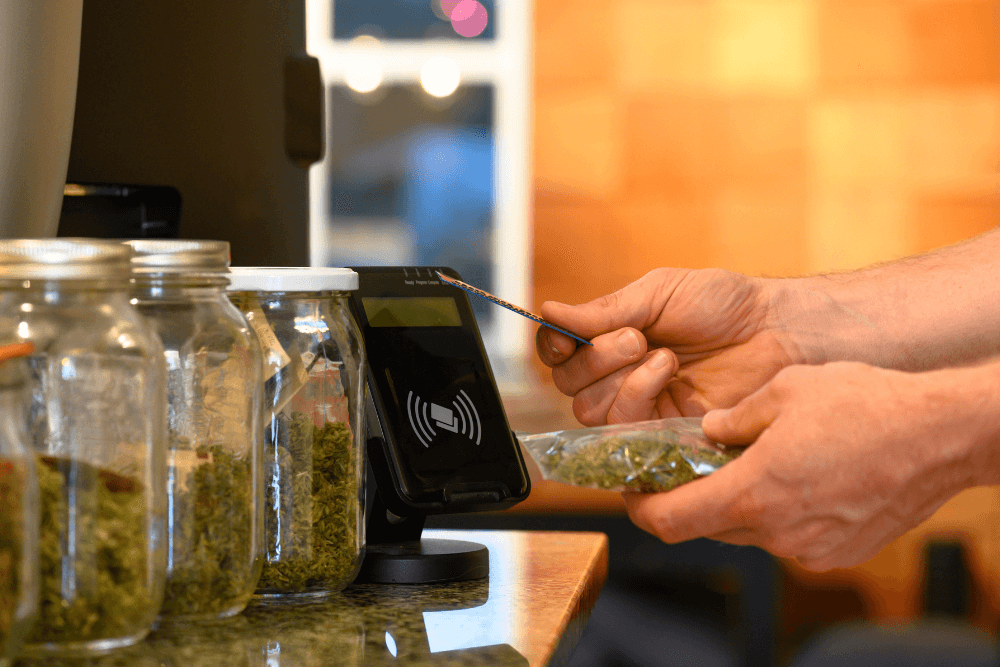
The cannabis market is growing globally at a considerably good pace. According to studies, did you know that increasing legalization, favorable cultivation norms, and the use of technology are some of the factors promoting the development of the cannabis industry?
Due to this, many researchers are projecting the growth of this market from $43.2 in 2022 to $72 billion in annual sales by 2030. While the industry as a whole is growing, however, some businesses are looking for ways to bring something new to customers.
But the question is, when change is the only constant in this market, how can you do it right? Well, don’t worry because we’re here to help.
This article mentions a few tips and suggestions on transforming your business with modern experiences and growing your profits. Let’s dig in!
Install Kiosks for a Better In-Store Experience
One of the best modern ways to elevate your cannabis store is to introduce user-friendly kiosks. These will help your customers find everything easily in the store.
Moreover, you can also increase the product range with these kiosks. For example, if you sell dry herbs, you can also place a station for pre-roll cones to transform into a one-stop store. You can buy pre-roll cones in bulk and make an addition to your business.
It will increase your customers’ convenience and boost your sales for better profits. So, invest in kiosks to transform the in-store experience and align with today’s shopping trends.
Embrace Technology
Another key player in providing a modernized experience to your customer is leveraging technology for your business. You should invest in user-friendly apps and convenient online delivery services to elevate customer experiences.
It is a great way to tap into the target group that seeks convenience and accessibility. Busy schedules often keep people busy, and they may not get the time to visit stores. Thus, providing an app to place orders makes it easier for them.
Likewise, you can consider further offering 24/7 delivery services to accommodate varying schedules and situations. It will not only increase your customer base but also help you stand out among your competitors.
Workshops and Events
Embrace a fresh approach to your cannabis business transformation by hosting workshops and events. It greatly enhances modern experiences. These gatherings help establish strong customer relationships and bring mutual benefits.
For customers, it’s a chance to learn, explore, and connect with fellow enthusiasts. They gain valuable insights into your products and their uses. Your business, in turn, gains loyalty and trust by offering educational and interactive opportunities.
You can conduct these events online and offline according to the demand. You can also introduce games, outings, and more for the community. Moreover, to enhance it further, you can also offer special discounts to the ones who attend your events. This positive connection leads to repeat visits and word-of-mouth recommendations.
Bottom Line
We hope the above information helps you modernize your cannabis business for success. You can use kiosks for easy shopping, embrace technology for convenience, and host engaging workshops. This builds happy customers and loyalty. These steps cater to changing preferences and show you’re a leader.
Member Blog: Cannabis Strain, Cultivar, or Variety? What Is the Correct Term?
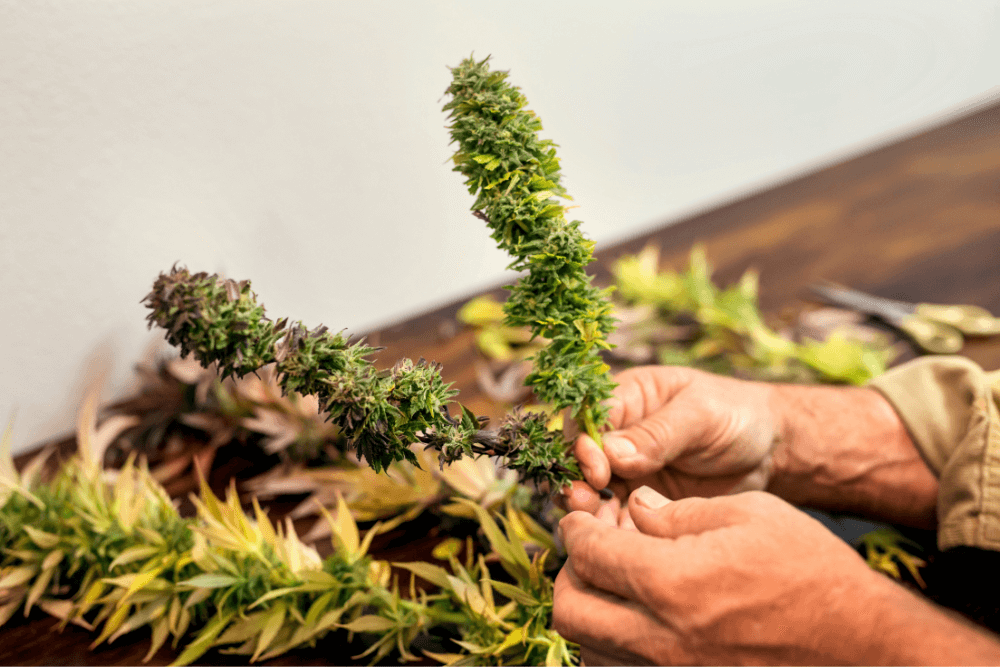
In cannabis cultivation, one often comes across the terms ‘strain,’ ‘cultivar,’ and, more commonly, ‘variety’ to describe the multiple variants of this versatile plant. While these terms are sometimes used interchangeably, it is crucial to acknowledge that each carries a unique significance. Accurate communication is truly important in this dynamic field, and gaining a comprehensive understanding of these differences is essential. In this article, we embark on a journey to unravel the dissimilarities among strain, cultivar, and variety in cannabis cultivation, shedding light on the nuances that shape this captivating community.
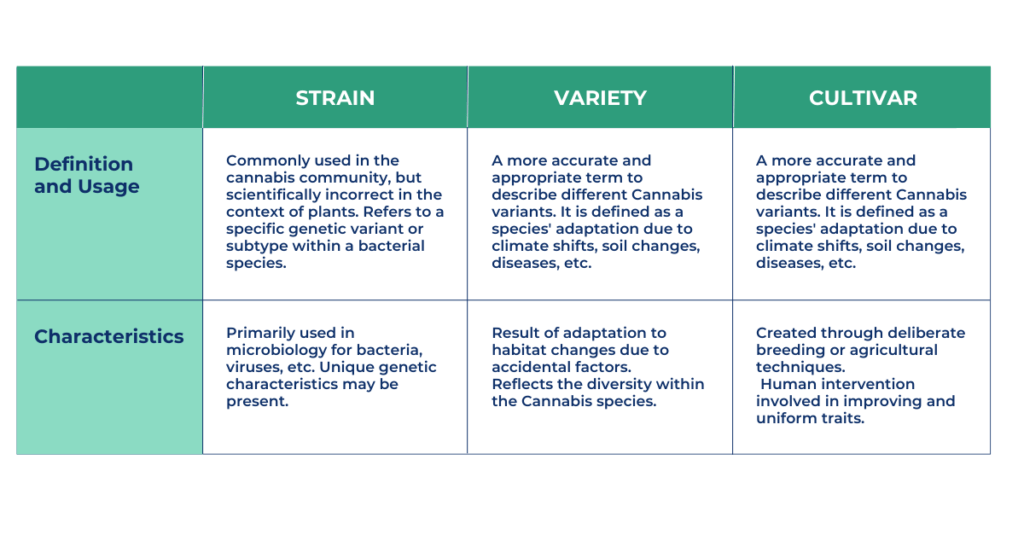 Strain
Strain
Commonly used in the cannabis community, the term “strain” is not entirely accurate when referring to variants of the Cannabis species. In scientific contexts, “strain” is primarily used in microbiology to discuss bacteria, viruses, and fungi (Russo, 2019). For example, in bacteriology, a “strain” refers to a specific genetic variant or subtype within a bacterial species. Each strain may have unique genetic characteristics, such as the presence of specific genes (Dijkshoorn et al, 2000).
However, when it comes to plants like Cannabis and plants in general, the use of the term “strain” is not appropriate, as it is a word reserved for the realm of microbiology. Therefore, we should avoid using it when referring to different variants of Cannabis species.
Variety
The term “variety,” on the other hand, provides a more accurate and appropriate way to describe different cannabis variants. The term “variety” is defined as a species’ adaptation resulting from changes in its habitat due to accidental factors such as climate shifts, soil changes, the presence of diseases, insect attacks, nematodes, and other similar influences (Arévalo et al., 2006). Therefore, when discussing different types of cannabis, “variety” is the most accurate term to use.
Cultivar
To avoid confusion with the botanical term “variety,” the term “cultivar” was coined. It is a combination of “cultivated variety,” shortened to “cultivar” (Arévalo et al, 2006). Unlike varieties, cultivars are not products of natural evolutionary processes. Instead, they are created through deliberate breeding or agricultural techniques to have improved and uniform traits (Tooker et al, 2012). This distinction is crucial, as it highlights the human intervention involved in developing specific plant traits and characteristics.
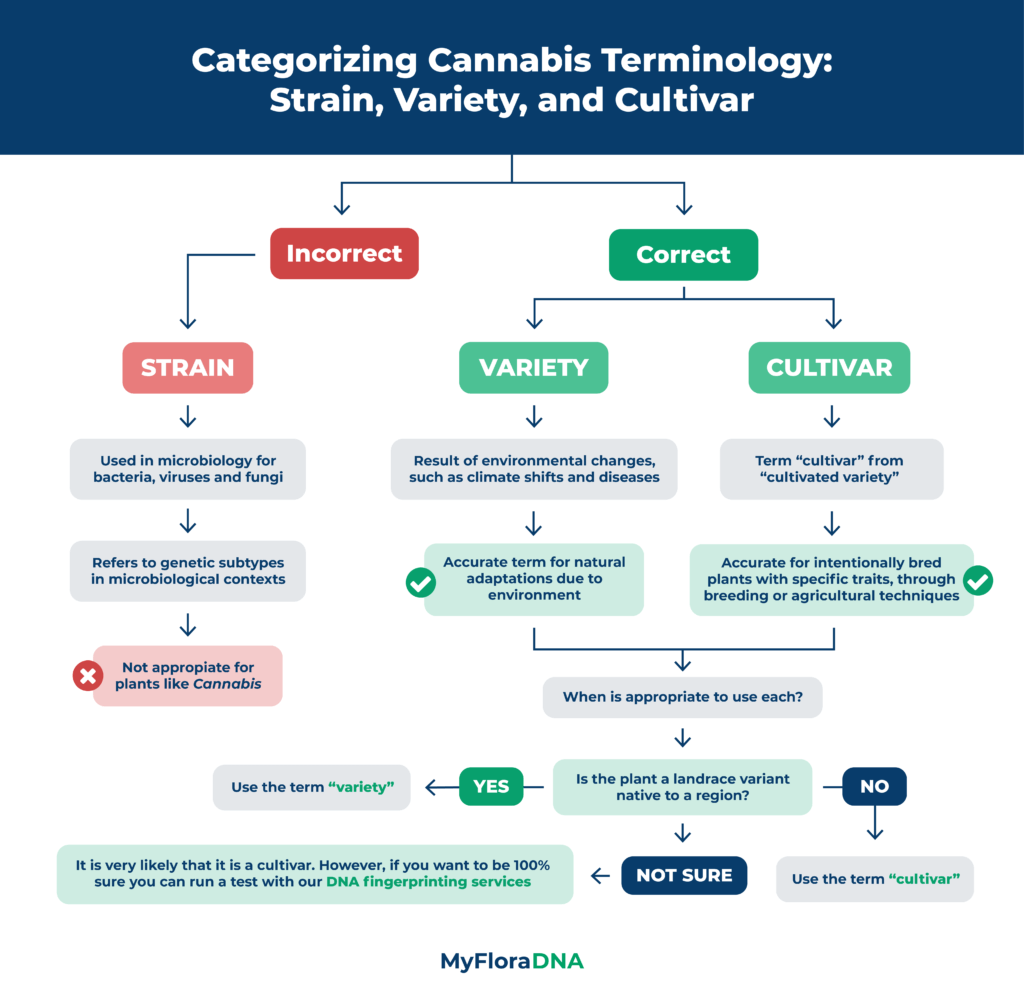
But, how important is it to distinguish between cultivar and variety in Cannabis? In the context of Cannabis, differentiating between cultivars and varieties is essential. Varieties refer to naturally occurring adaptations of the plant due to environmental factors, while cultivars encompass those that have been intentionally bred and developed by humans. For example, a landrace variant found growing naturally in its native region would be considered a variety, whereas a hybrid variant carefully created through crossbreeding different varieties would be classified as a cultivar.
Finally, why should we care about using the correct terminology? Understanding the distinctions between “strain,” “variety,” and “cultivar” is more than just semantic pedantry; it has practical implications for various stakeholders:
- Scientific accuracy → Employing correct terminology helps maintain scientific integrity and clear communication among researchers, botanists, growers, nurseries, and enthusiasts. All must adhere to precise terminology to communicate effectively, exchange knowledge, and avoid misunderstandings.
- Consistency → Consistent use of the terms “variety” and “cultivar” promotes a unified understanding within the cannabis community and the broader horticultural and botanical fields. Standardizing the usage of these terms will aid in streamlining scientific research, regulatory practices, and consumer education within the cannabis industry.
- Preservation of biodiversity → Understanding and distinguishing between natural varieties and cultivated cultivars contribute to the preservation of Cannabis biodiversity.
In summary, although the terms “strain,” “cultivar,” and “variety” are frequently used interchangeably in the cannabis community, they hold distinct meanings. Recognizing the proper usage of each term is essential to enhance clarity and ensure accurate communication. By understanding the differences between these terms, we can better appreciate the diverse and captivating world of cannabis, as well as the diligent efforts invested in developing unique and desirable cultivars.
References
Arévalo, R. A., Bertoncini, E. I., Guirado, N., & Chaila S.. “Los términos cultivar o variedad de caña de azúcar (Saccharum spp.).” REVISTA CHAPINGO SERIE HORTICULTURA, vol. 12, no. 1, 2006, pp.5-9. Redalyc, https://www.redalyc.org/articulo.oa?id=60912102
Dijkshoorn, L., B. M. Ursing, and J. B. Ursing. “Strain, clone and species: comments on three basic concepts of bacteriology.” Journal of medical microbiology 49.5, 2000, p. 397-401. https://doi.org/10.1099/0022-1317-49-5-397
Mostafaei Dehnavi, Mahboubeh, et al. “THC and CBD Fingerprinting of an Elite Cannabis Collection from Iran: Quantifying Diversity to Underpin Future Cannabis Breeding.” Plants, vol. 11, no. 1, 2022, p. 129, https://doi.org/10.3390/plants11010129
Russo, Ethan. “The Case for the Entourage Effect and Conventional Breeding of Clinical Cannabis: No “Strain,” No Gain.” Frontiers in Plant Science, vol. 9, 2019, p. 434025, https://doi.org/10.3389/fpls.2018.01969
Tooker, John, and Frank, Steven. “Genotypically Diverse Cultivar Mixtures for Insect Pest Management and Increased Crop Yields.” Journal of Applied Ecology, vol. 49, no. 5, 2012, pp. 974-985, https://doi.org/10.1111/j.1365-2664.2012.02173.x
Breaking Down the Recent Cannabis Rescheduling Recommendation

For more than fifty years, the federal government has maintained that cannabis is a Schedule I drug, meaning that it has a high potential for abuse and no accepted medical value. That changed last week (somewhat) when the Department of Health and Human Services (HHS) recommended to the Drug Enforcement Administration (DEA) that cannabis be placed in Schedule III, meaning that it has moderate to low abuse potential, a currently accepted medical use, and a low potential for psychological dependence.
Why now?
In October 2022, the Biden Administration announced that it would ask the Secretary of HHS and the Attorney General to initiate the administrative process to review expeditiously how marijuana is scheduled under federal law. As the Brookings Institute outlined years ago, the Executive process for rescheduling is much more complex than the Legislative path.
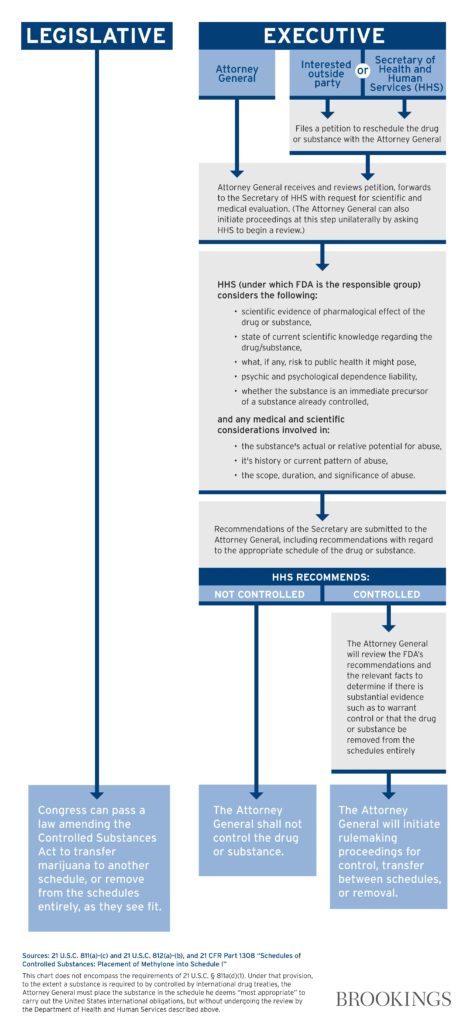
It’s no secret that the presidential election is barely more than a year away, and the President seems to be looking to make good on his campaign promise to reform the nation’s marijuana laws.
What does this mean?
First off, it’s critical to note that HHS’ recommendation to DEA is just that: a recommendation. It is non-binding. The DEA may come to the same conclusion that HHS did, but is not required to.
If cannabis is moved to Schedule III of the Controlled Substances Act, one positive outcome would be that 280E would no longer apply to plant-touching businesses, removing an incredibly punitive and debilitating provision in the tax code.
According to NCIA’s board chair emeritus, Khurshid Khoja, Esq., “…it’s important to remember that rescheduling would not apply the federal Food Drug and Cosmetic Act (FDCA) to marijuana for the first time—it applies right now, and like the federal Controlled Substances Act (CSA), would continue to apply after rescheduling. But absent any statutory authority permitting FDA to do otherwise, the FDCA would continue to apply after descheduling too, just as it does to hemp products.”
Others claim that the shift to Schedule III would have minimal impact on businesses and individuals. Here at NCIA, we’re cautiously optimistic but recognize that moving cannabis to schedule III could have some limited benefit but does nothing to align federal law with the 38 U.S. states which have already effectively regulated cannabis for medical or adult use.
What now?
Now that HHS has made their recommendation, the DEA will begin its scheduling review process.
Many are divided about what a move to Schedule III would actually look like. Yes, there would be the elimination of 280E, but what about enforcement priorities? Interstate commerce? Criminal penalties? There are so many unknowns.
NCIA has previously produced a common sense, workable roadmap for that federal comprehensive reform and provided detailed feedback on legislative efforts. It is time for Congress to follow the will of the American people. Don’t get me wrong, there’s no doubt that this recommendation is a step in the right direction and is long overdue. But we can’t lose sight of the ultimate goal: removing cannabis from the Controlled Substances Act entirely.
Have questions?
Join NCIA on September 14 at 1 pm ET for an engaging webinar where we will unpack all your questions! Register today and don’t miss your chance to hear more about what this means for the cannabis industry and your business.

Committee Blog: Why 1% Total THC Could Open New Doors for the Hemp Industry

Published by NCIA’s Hemp Committee
As we look forward to the 2023 US Farm Bill, there’s a substantial opportunity to modify the regulations around hemp cultivation and usage. Adjusting these regulations can stimulate the growth of the hemp industry while still ensuring consumer safety. The potential of hemp as an agricultural product is vast, with applications including food, fuel, fiber, building materials, grain, and medical use. It’s important to note that while cannabinoids often dominate the headlines, they make up only a small slice of the industry’s potential size.
Experts predict that incorporating hemp into cosmetics, construction materials, and textiles could catapult the industry to over $1 trillion in annual sales. However, the current regulations pose significant challenges to this innovative industry’s expansion, especially for conscientious farmers. The fear of having their crops destroyed because of slightly exceeding a set THC limit is a serious obstacle.
At present, the definition of hemp rests on a Total THC limit of 0.3%, a figure chosen in the 1970s for classification purposes, not for assessing the plant’s psychoactive effects. Bumping this limit up to 1% Total THC would have a negligible impact on impairment but could have a monumental effect on farmers’ operations.
Research from 2020 by the University of Illinois, University of Wisconsin, Michigan State University, and Purdue demonstrated that more than half of the common hemp varieties could surpass the Total THC limit under certain conditions. However, this research also revealed that only 4% would breach the limit if it were raised to 1%.
Growing hemp that exhibits desirable traits for industrial uses, like a long straight stalk, high fiber, or high seed yield, requires the plant’s full maturation. This maturation is often linked to higher THC profiles. Unfortunately, the current strict conditions and genetic variation restrictions severely limit the plant’s potential applications.
While responsible hemp growers are in favor of state-led regulations for cannabinoid extractions that can cause impairment, it’s clear that an unrealistically low THC limit isn’t the best approach. Other nations, such as Thailand, Mexico, and Switzerland, have already updated their regulations, defining hemp as containing up to 1% Total THC.
By making a small change to the legal definition of hemp, we can unlock the industry’s potential. It will allow farmers across the nation to make the necessary investments to keep pace with an industry set to grow from being worth billions to trillions of dollars. By encouraging this change, we can foster American innovation and boost rural economies, reinvigorating the manufacturing sector in the process. Now is the time to recognize and adapt to the potential of this versatile plant.
How can you help?
Remember, members of Congress are elected to represent the interests of their constituents – that’s you. But they can only effectively do so when they’re fully informed about the issues that matter to you. Your voice is powerful and essential to our democratic process. By speaking up, you can provide important insights and help shape the future of the Hemp Industry.
- Send an email to your members of congress.
- Reach out directly to your Representative and Senators
Member Blog: Quality Buds, Quality Source. Which Is Better, Seeds or Clones?
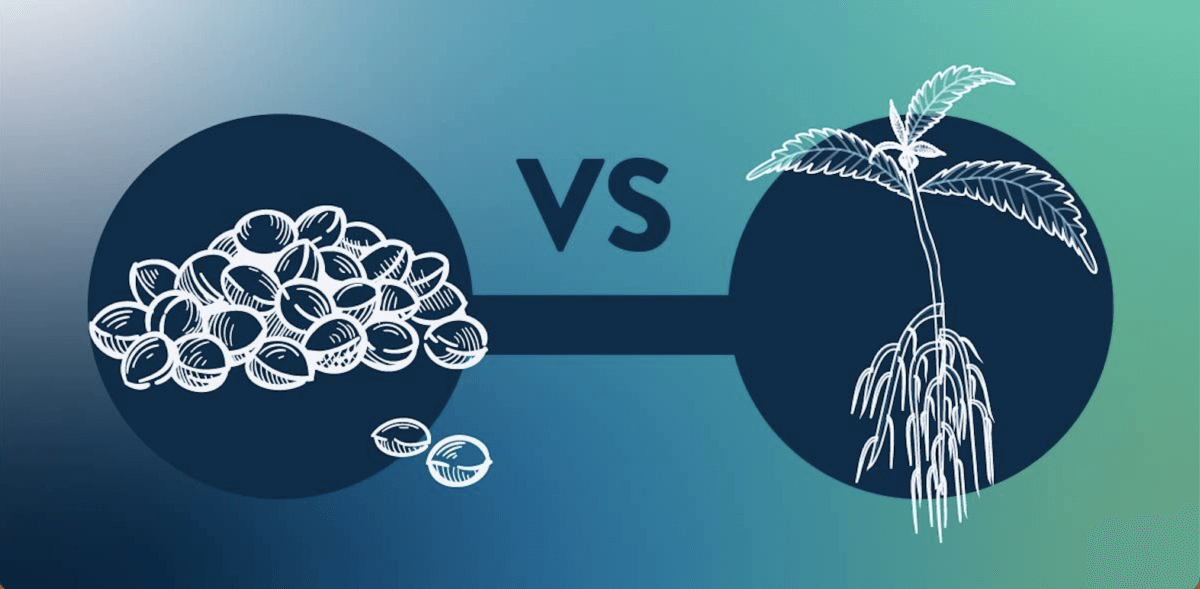
Ask 10 cultivators the best way to grow quality cannabis and you will get ten different answers. From growing medium to nutrients to watering schedule, every cultivator thinks they have dialed in the magic recipe for premium buds. One area where the debate rages is whether it is better to grow from seed or clone. To be fair, both have their pros and cons.
Some prefer to grow from seed because they feel seeds yield a hardier plant, whereas clones are more of a carbon copy of the original; exactly the same but not as vibrant. Thinking about the copy machines of yore, after a few copies, the ink would get lighter and the background less crisp. Some claim that clones provide the same experience. Another benefit to growing from seed is breeding. Since clone mothers are female, all their cuttings are female. If a cultivator wants to cross two cultivars, some males need to be added to the mix. For others, the assured female offspring of the mother plant reduces waste and time, as well as the chance that a rogue male will pollinate the garden. Another benefit of growing from clone is that, because it is a carbon copy of the mother, growers can replicate desired strains for the consumer. And while you can procure seeds from a prize-winning cultivar to grow, there is a chance that, like siblings, the final product will be a bit different than the one before.
For home growers, clones may be preferable because the seedling stage is a very vulnerable one for the little plant. I know that I tried to grow from seed unsuccessfully for a year when I first started until I was gifted an adolescent female. On the other side, since seeds have been deemed a hemp product by the DEA due to containing less than .3% THC, they are easier and safer to ship from place to place, which is a bonus for someone in NY who is excited about a strain from CA. And since clones require a mother room if you want to use the same source plant repeatedly, there is a larger space requirement for growing from clone. In the end, the decision to grow from seed or clone will vary from farm to farm, with some farms, commercial or home grow, choosing to do both. According to the 2023 Home Grow Report from New Frontier Data, 44% report growing from seed, 13% from clone, and 40% use both.
How about you? Are you a licensed cultivator who has opinions on whether it’s best to grow from seed or clone? New Frontier Data is conducting a survey of licensed cultivators in the US and Canada, and we want to hear from you! We are especially interested in cultivators from AZ, CA, CO, FL, MI, OH, OK, British Columbia and Ontario, but all licensed cultivators are welcome to complete it! The survey takes about 10 minutes, is confidential, and if you complete it, you will receive a summary of the results in your state AND be entered to win a $100 Amazon gift card! You can take the survey at: https://hubs.la/Q01_0FFm0
Committee Blog: Navigating the 2023 Cannabis Harvest Season – Balancing Labor Costs, Worker Safety, and Automation
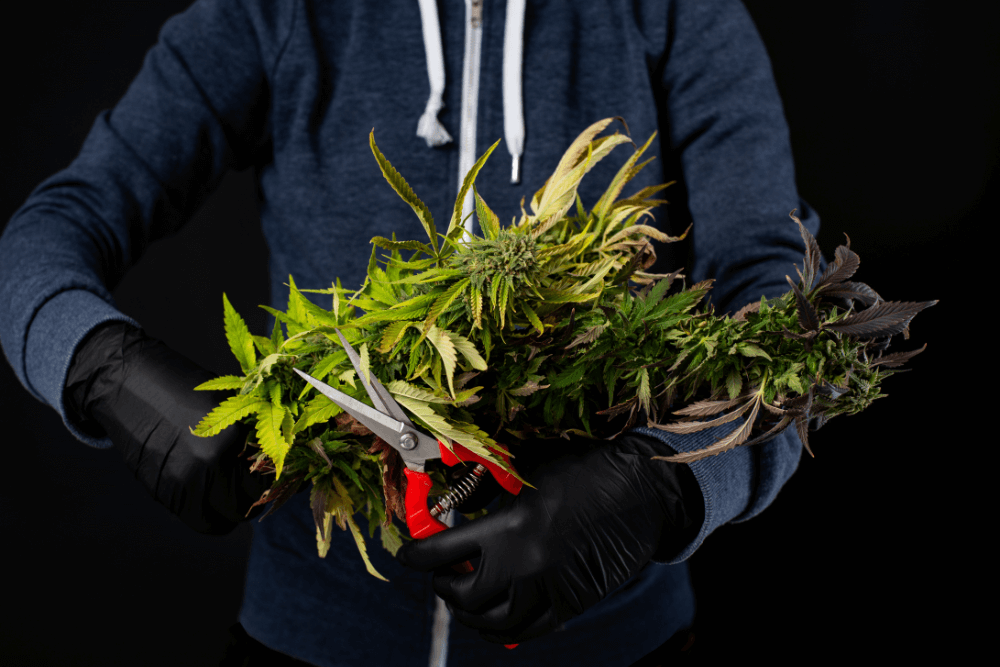
As we enter the Fall cannabis harvest season of 2023, several dynamics impacting human resources in the cannabis industry have shifted considerably. Between escalating labor costs and the imperatives of ensuring safer working conditions, the landscape for cannabis industry employers isn’t what it used to be.
Here are three recommendations to help you navigate workflows this harvest season:
1. Proactive Planning Amidst Rising Labor Costs:
Labor costs in the cannabis industry have seen a sharp surge in recent months. Where we saw hourly rates for harvest workers in years past at $12-$20/hour, this range is now closer to $14-$25/hour, depending on the market. This uptick isn’t just a reflection of rising expectations among industry employers, but also a clearer sense of the safety risks involved, what experienced cannabis harvest workers are willing to work for, and the number of such workers who have left the industry entirely in recent months. For cannabis companies, this necessitates early planning. Human resources departments need to remain agile to adapt to these changes in the labor market.
To address this, a multi-pronged strategy is best. If you’re still finalizing your harvest approach, consider a blend of hiring seasonal talent while also investing in some automation. By leveraging the unique strengths of both seasonal and full-time workers, along with automation, you can tap into hands-on expertise, while enjoying the benefits of flexibility and cost-effectiveness.
2. Prioritizing Worker Safety:
The increasing global temperatures, a distressing trend for many cultivators, has implications for outdoor and greenhouse workers. HR professionals need to be proactive in revising Safety protocols to protect workers from the adverse effects of heat. Regular breaks, shaded areas, hydration stations, and training on recognizing heat-related illnesses are no longer optional. In certain areas, you may want to consider having your crew come in earlier than usual, before the weather heats up, as long as you have adequate lighting in place so the team can work safely.
If you operate in remote locations or places farther from urban centers, it becomes even more crucial to ensure nearby amenities and facilities are optimized for the warmer climate. This includes considering air-conditioned accommodations, cool showers, or providing cooling stations on-site. Keep a list of essential nearby services, and ensure they cater to the needs of workers battling higher temperatures.
In light of respiratory concerns, especially in indoor processing settings, invest in premium Personal Protective Equipment (PPE) for tasks like handling kief, resin, and pre-rolls. This PPE can also be used by workers outdoors when there are some air quality concerns due to fire season. It is not safe for workers to be out when air quality is poor. Check with your Worker’s Compensation provider to see what the threshold is for your policy.
If you’re looking for Work Site Safety or OSHA guidance, please reach out to NCIA’s HR Committee for recommendations.
3. Integrating Automation with the Human Touch:
2023 is undeniably a pivotal year for integrating automation in the harvest process. Advancements in technology offer tools that can help streamline multiple stages of the harvest. While there are certain upfront costs involved, there are also long-term benefits to be had in terms of overall profitability and efficiency. While much of the available machinery has a way to go before being as accurate as an experienced Harvesting Tech or Trimmer, especially for growers in remote areas, where there isn’t a large pool of talent, leaning more on automation could make the difference between harvesting your cannabis at its peak, or not.
You can also look to our related NCIA blog post from 2021 for additional suggestions to help you prepare for the Fall harvest. Navigating the harvest this season will require forward-thinking, investment in a combination of seasonal workers and technology, along with a renewed commitment to worker well-being. As challenges continue to mount in our industry, the companies that adapt and prioritize both efficiency and worker safety will undoubtedly reap the greatest rewards.
Member Blog: Adult-Use Cannabis Now Legal in Maryland – A Look at the New Law

In the heart of the East Coast, Maryland stands as a state rich in history and diversity. But now, it’s making headlines for quite a different reason.
In a significant move, the state has crossed one of the biggest milestones of its legislative journey- adult-use cannabis is now officially legal.
Of course, the decision comes after much debate, consideration, and reflection on the impact this will have on society. However, this law is sure to change the way cannabis is viewed, controlled, and used within the state.
The following article explores the details of this landmark law, what it means for Maryland’s future, and how customers can get their hands on adult-use cannabis.
Let’s cut to the chase!
The New Cannabis Law In Maryland: Explained
The journey of legalizing cannabis for adult-use began in the 2022 General Election. During these elections, voters gave a nod in favor of allowing adults aged 21 and older to use cannabis. This came into effect on July 1, 2023.
But what did this mean for the state?
Well, during the 2023 legislative session, lawmakers got to work. They passed a law called House Bill 556/Senate 516, describing the rules for legal sales of cannabis, including how to license sellers and how to tax them.
This change was sealed when the Cannabis Reform Act got the Governor’s signature on May 3, 2023. This Act was like a green signal for licensed shops to sell both medical and adult-use sales. So, by July 1, there was an official marketplace for adult-use cannabis.
But that’s not all! The Act gave more powers to the Maryland Cannabis Administration. They were tasked with issuing more licenses to those growing, processing, and selling cannabis. There was also something new – the incubator licenses. All these licenses were set to be released in two phases.
Highlights of The New Law:
- Adults aged 21 and over can legally possess, consume, and grow marijuana for personal use.
- The legal limit to possess cannabis is:
- Up to 1.5 ounces of flower
- Up to 12 grams of concentrated cannabis
- The product contains up to 750 milligrams of delta-9-THC.
- Public consumption remains illegal.
- Driving under the influence of marijuana is still a criminal offense.
- Expungement of certain marijuana-related convictions, giving thousands of individuals a fresh start.
- Under federal law, cannabis is still prohibited; that’s why transporting or carrying it across state borders is not allowed.
|
How Can Someone Buy Cannabis Products For Adult-Use?
Purchasing cannabis products for “non-medical” use is pretty easy now. If you or someone you know wish to get their hands on these products, follow this simple guide:
- You need to be 21 years old or older. That’s the legal age for buying cannabis products for adult-use in Maryland. Remember to carry a valid photo ID to confirm your age when visiting a dispensary.
- Dispensaries or stores have a variety of options to choose from. So, whether you’re interested in edibles, flowers, tinctures, or topicals, it’s essential to check them out to find the product that suits your preferences. You can even ask questions to make a well-informed decision.
- Though you don’t require a medical card to buy cannabis, you do have to keep the maximum limit of possession in mind and follow all the state regulations. It will help avoid potential penalties or legal troubles at the federal level.
That’s all! Now, you can enjoy the benefits of this popular herb from the comfort of your home.
What Would Be The Implications Of This Law in Maryland?
Well, just like any law amendment and law regulation, this milestone has also brought along a few implications that include:
Economic Implication
The legalization of adult-use cannabis in Maryland is set to have significant economic implications. Tax revenues from cannabis sales are estimated to bolster state funds, allowing for investment in various public services like education, healthcare, and infrastructure.
The growth of the cannabis industry will likely create new jobs, supporting the local economy and providing opportunities for entrepreneurs and workers alike. Proper regulation can further ensure that the economic benefits are widespread and sustainable.
Social Implications
The state has taken a significant step, and this is because people’s feelings and opinions about cannabis are changing. This is reducing the age-old stigma related to its consumption and other uses.
In addition to this, the new law allows for expungement of prior convictions related to its possession and use. This is a step for righting past wrongs, positively impacting countless lives, and offering them a second chance to build their lives.
Educational Initiatives
Education is one of the key components of Maryland’s approach to cannabis legalization. Basically, the plan is to implement public education campaigns aimed at informing residents about responsible use, potential health risks, and legal boundaries.
These educational initiatives are vital for ensuring that people, especially young ones, understand the new law’s nuances and potential health implications. Such awareness is crucial in preventing misuse and fostering a responsible approach to adult-use cannabis.
Moreover, this will make regulation of the law much easier, transparent, and responsible. In fact, law enforcement agencies have also provided clear guidelines on the legal use of cannabis, emphasizing the continued illegality of driving under the influence, underage possession, and other related offenses.
Key Takeaways: A Historical Moment for Maryland
The decision to legalize adult-use cannabis in Maryland isn’t a minor tweak in legislation. It’s a significant moment, marking the state’s progressive stance in acknowledging changing societal views and personal freedoms.
In fact, it’s about dollars and cents too. With regulated sales and businesses springing up, the state stands to gain from additional tax revenue and job creation. The state has shown foresight. The legalization comes with robust educational initiatives and strict safety regulations.
From ensuring quality control of products to launching public education campaigns, the state is determined to prevent misuse and ensure responsible consumption. Ultimately, it’s a multifaceted approach shaped by careful deliberation, public interest, and a vision for a better future.
Member Blog: How to Avoid the 4 Most Common Payroll Mistakes

To achieve your goals in business, your payroll system must be flawless. It is an aspect in which you must strive for perfection whenever possible. Avoiding payroll mistakes in the cannabis industry is especially crucial due to the highly regulated nature of the industry. Compliance with payroll regulations is essential to avoid legal repercussions and penalties from governing agencies. Additionally, accurate and timely payroll ensures proper compensation for employees, and maintaining precise payroll records promotes transparency and accountability, building trust with employees and stakeholders in an industry where transparency is vital.
It is better to be safe by managing your payroll as thoroughly as possible, if not you would be sorry you didn’t. Most people have most likely made these mistakes and have had minor consequences accompanying them. If these mistakes persist, the business owner often pays dearly for them. These common payroll mistakes have cost some their business.
Having Multiple Records for a Certain Payroll
It pays to have all your payroll information in a single database. This enhances security and ensures that you know where to look for your payroll information. If this has been your practice and your business uses tools like HCM software that helps you manage your employees and other business information, then this shouldn’t be much of a problem.
All you’ll have to do is use that same software to manage and process payroll information. If your business documents are disorganized, be sure to have them all in one place.
Not Updating Needed Information
Ensure that you are not complacent by relying on automated software to do everything. The system is not aware that your employee would be changing addresses therefore such info should be entered manually.
That error could lead to mistakes in filling that employee’s taxes as the bills might arrive at the wrong address. As much as simplifying a process is great, you still need to play your path in getting things done.
It would help you to set timely reminders in the system that should help you avoid the mistake of not keeping up with the latest information.
Weak Security System
Confidential information should remain so. To avoid your system being compromised, you should be using a payroll processing system with strong cybersecurity.
This has got to be the costliest mistake common to payroll processing. Every information concerning your business that is not available on your website and to your customers, is most likely not public information. Private information about your business should remain private.
Information in payroll systems is as sensitive as can be. There’s almost every piece of information you need to know about a person, and as such strict rules should apply to keeping them safe. A weak security measure means a weak business and a weak business means trouble.
Inaccurate or Delayed Tax Payments
In calculating taxes absolute precaution is required. If you are not a tax accountant you are probably not so proficient in this calculation. Your tax accountant (if your business has one) should learn how to adequately use the system to avoid delay or inaccuracy.
Bear in mind that inaccurate tax payment makes your business a tax defaulter. Your business as a taxpayer has the duty of tax calculations assigned to an accountant. Note that taxes ought to be paid within the required time bracket. The systems are programmed to make the tax payments when due.
The human capital management system does not only process payroll information but can also tell when employees qualify for federal or state tax credits.
In Conclusion
To maintain payroll accuracy and timeliness in the cannabis industry, it is crucial to avoid payroll mistakes. By opting for a third-party payroll provider like Tesseon you can benefit from our expertise and ensure that your payroll is consistently accurate and delivered on time, regardless of any industry-specific challenges. The Cannabis industry is both very young and extremely regulated, it is imperative that businesses stay vigilant and proactive to avoid costly mistakes.
Member Blog: The SAFE Banking Act Is Delayed. Again.

Here’s what cannabis businesses can do to make the most out of the current financial landscape.
Companies in the cannabis industry looking to start a relationship with federal banks and credit cards are going to have to wait a little longer. Despite bipartisan support, the Secure and Fair Enforcement (SAFE) Banking Act has stalled in the Senate; caught in minor disagreements, it has missed the opportunity for a vote during the summer session, leaving cannabis-related companies caught in financial limbo. Unfortunately, this isn’t new news: the first version of this bill was introduced to congress 10 years ago.
Politically, the main selling point is that the bill would boost the safety of the cash-heavy industry: Politicians point to an increased number of break-ins at dispensaries as a justification for allowing federal financial institutions to provide services such as bank accounts and credit card transactions to cannabis companies.
An easy political sell, the public safety angle – spelled out in the acronym SAFE – is usually the first (and only) benefit mentioned in the news. Yes, SAFE would allow dispensaries to shift away from cash transactions by permitting credit card companies to service businesses that produce, manufacture, distribute and sell cannabis, despite the fact it is a schedule 1 controlled substance.
But beyond preventing robberies, the bill would start to level the economic playing field for this growing industry that already faces an extremely high rate of federal taxation, on top of other disadvantages, such as higher transaction and banking costs that lead to pricing pressure – and make it tougher to compete with the illicit market.
Because of cannabis’ schedule 1 status, nationwide banks are not allowed to provide any services whatsoever to cannabis-related businesses. Even though the businesses are legal at the state level, national banks operate under a federal charter that prohibits such relationships – not just with dispensaries, anyone who does business with the cannabis industry – web designers, lawyers, marketers, etc.
(I learned that the hard way when, in the early days of working as a virtual CFO for cannabis companies, I had all of my Bank of America accounts – personal and business – frozen and shut down abruptly.)
Since federal banks cannot provide small business loans or even issue checking or savings accounts, cannabis-related businesses are limited to small banks (i.e. credit unions, state banks). They face higher borrowing costs, and receive lower interest rates, cutting them off from many of the privileges other industries enjoy. Best financial practices – like securing a line of credit or keeping operating cash in an interest-bearing account – may seem out of reach.
For cannabis-related companies that had been impatient to take advantage of this new legislation, the news is frustrating to say the least.
But there are lots of ways retailers can work within the current financial landscape. Here’s what I recommend.
- Seek an interest-bearing account – The smaller banks and credit unions servicing the cannabis industry typically do not offer these clients interest-bearing products. However, it is possible to find interest-bearing accounts for operating cash, for example through the fintech company Safe Harbor Financial, with rates starting around 1.5%.
- Secure a line of credit – With loans hard to come by, cannabis companies often feel as though they have to access capital from private investors, forcing them to give up equity. But seeking non-dilutive funding is possible – and recommended – once you’ve established your target operating cash balance of 10-30% of annual revenue.
Many cannabis friendly banks will offer unsecured lines of credit at rates of base rate +4% – but generally only in limited license states.
Note: although rates can be competitive in some cases, the amounts tend to be lower. However, since these facilities are often based on an amount per tax ID, multiple entities could each carry their own line of credit and increase total borrowing capacity.
- Facilitate compliant debit sales – We know cash-only can drive down retail sales and increase risk of theft or employee mismanagement. With credit cards unavailable, two popular, but non-compliant, solutions have been cashless ATMs and Mastercard and Visa debit cards. While cashless ATMs experienced a crackdown last December, the latest news suggests that Mastercard is also cutting off this popular work-around.
Rather than get caught up in the headlines, adopt compliant pin-based debit cards, through products such as Aeropay. Unlike traditional debit card transactions, customers will have a fee, and they’ll also have to set up a specific app to gain access, but as all other cashless options appear to be erased, the benefits outweigh the costs, especially for regulars.
Just make sure you’ve got a point of sale (POS) system with flexibility in terms of their API (application programming interface) – for example Flowhub – so that you can integrate the pin-based debit card payment method.
- Don’t pay monthly banking fees – While most banking institutions charge account fees to cannabis businesses, with a little research you can find some that waive those fees, for example Main Street Bank and Safe Harbor Financial.
- Keep deposits safe – Although the dust has settled since the collapse of Silicon Valley Bank, cannabis businesses should still keep an eye on managing their banking risk. Since programs like CDARS and ICS are not available to the industry, we recommend cannabis operators keep deposits at multiple banks to keep the highest possible FDIC insured balance.
Despite these financial obstacles and policy roadblocks, the cannabis industry continues to grow, year after year. Accessible banking products are out there – and as we wait for more federal legislative progress, it can be well worth the investment to do a little research to find out which ones best meet your businesses’ needs.
Member Blog: 5 Types of Business Insurance You Should Consider

As the cannabis industry continues to rapidly expand and evolve, entrepreneurs need to be proactive in safeguarding their businesses from potential risks. Insurance is crucial for any business, and the cannabis sector is no exception. In this article, we will explore five important types of business insurance specifically tailored to the needs of cannabis entrepreneurs. By understanding these essential policies, cannabis industry professionals can make informed decisions to protect their investments and future-proof their ventures.
General Liability Insurance
General liability insurance covers the cost of any injury or damage caused by your business. This includes injuries on your premises and injuries to someone while using your products or services. It also covers you if someone is injured while on your property, even if they’re not part of an organized event or program (like a birthday party). General liability insurance will also cover the cost of any lawsuits filed against you for negligence or breach of contract arising out of the above scenarios.
Professional Liability Insurance (Also Known As Errors And Omissions)
Professional liability insurance, also known as errors and omissions insurance, protects you from lawsuits if a client feels you have made an error in your work. This can be anything from a client claiming that you didn’t perform according to the contract terms or did not fulfill their expectations.
This coverage differs from general liability protection in that it only covers claims against professional services like accounting or legal services. If you own a business where your products or services could physically injure customers, you also need general liability coverage (more on this later).
The good news is that most businesses need both types of policies: professional liability for the expertise required for running their business and general liability for protecting themselves against bodily injury incurred by customers using their products/services.
Business Interruption Insurance
A business interruption policy provides coverage for losses that result from the sudden, unforeseen loss of use or operation of your business. For example, if you’re forced to close your doors because a fire destroyed your building, this policy will pay back some of the revenue you lost during that period. Business interruption insurance can be purchased as part of a multi-line or a stand-alone policy.
Workers’ Compensation
The next type of insurance to consider is workers’ compensation insurance. This form of insurance covers the cost of medical expenses and lost wages for an employee who has been injured on the job. In all states, workers’ compensation policies are required by law, but you may want to add additional coverage for your business if there is a high risk of injury among your employees. Your premiums will be higher if you have a larger number of workers or more dangerous jobs than others in your area, so it makes sense to review this kind of coverage before purchasing it.
Employment Practices Liability (EPL) Insurance
Employment Practices Liability (EPL) insurance can be a lifesaver for small businesses, especially when there are multiple employees.
EPL insurance protects your business from sexual harassment, discrimination, and wrongful termination claims. It also provides coverage for defending these types of claims against you.
If you’re doing business in certain industries, EPL policies are often required by law or rely on government contracts to run your business. A few examples include healthcare providers, educational institutions, restaurants, and hotels—though it varies by state, so check with your insurance agent before purchasing a policy.
Conclusion
The bottom line is that you should consider your business insurance needs carefully and ensure adequate coverage. If you’re unsure about what type of insurance to get or how much coverage is enough for your business, please speak with an agent or broker who can help guide you through these decisions.
Committee Blog: Banking in the Cannabis World

By: Shawn Kruger, Avivatech
Contributing Authors: Paul Dunford, Green Check Verified | Todd Glider, MobiusPay Inc. | Kameron Richards, Kameron Richards Esq.
Produced by: NCIA’s Banking & Financial Services Committee
The Landscape
With recreational marijuana legalized in 23 states, Washington D.C. and Guam, the public continues to broadly favor legalization for medical and recreational purposes. Why then, is it still a challenge for the cannabis industry to access financial services? The short answer: cannabis banking is risky for financial institutions (FIs), and bankers are committed to avoiding unnecessary risk. Historically, FIs have worked to keep funds associated with illegal activity out of their banks and credit unions, so FIs are sensitive to conflicting state and federal cannabis laws. For example, many FIs are regulated by federal agencies, but marijuana is a Schedule I controlled substance.
Navigating the Challenges
However, there are many banks and credit unions that have taken this risk for a variety of reasons, including creating new sources of income, a desire to serve the unbanked in their communities, and supporting the social equity initiatives in the cannabis industry. These FIs are usually discreet about their cannabis banking programs, and it’s often hard to identify them through your typical approach: prowling websites, Google searches or even trade shows (although this has improved over the past 12 to 18 months).
Fortunately, the best approach is also a well-trusted option: word of mouth. Contact lawyers, accountants and bookkeepers in your area. If they represent or work with other local marijuana related businesses (MRBs), they may know who they are banking with or know someone who does. You should also consider contacting the FIs directly, even if you don’t know if they are working with MRBs. You might be surprised to find that they do, and if they don’t, they might redirect you to another FI in the area. Finally, organizations like the PBC Conference team, provide resources to aid your search, including a Cannabis Banking Directory published annually.
Focus your search on credit unions, community banks, and regional banks. We are entering a new phase of cannabis banking with some FIs offering more than just a place to park your cash. A growing number now offer loans, payroll services, business insurance, etc., so take time to see what’s available, compare multiple FIs’ programs, and find the best match for your cannabis-related business’ (CRB) needs.
Be Prepared
Every action taken by an FI, regardless of their location or asset size, is closely scrutinized by state and federal banking regulators, and law enforcement agencies. They want to make sure that banks and credit unions are only working with legitimate and legal state CRBs. Therefore, you can expect an FI to require a combination of the following:
- Driver’s license or other acceptable state-issued identification for all account holders
- Information on all beneficial owners of the company, not just those who own a percentage of the company above a certain percentage threshold (such as 20%)
- Tax returns for the previous year for both the company and the beneficial owners
- Financial information such as profit and loss accounts and capitalization tables
- A copy of any required state licenses
- Operational data such as projected annual sales and number of patients/customers
- Corporate formation documents such as articles of incorporation and business plans
- Sales transaction data (store reports or invoices) for the past thirty days
Behind the scenes of cannabis banking, FIs must do a lot to ensure that they are onboarding only legitimate CRBs; from collecting and analyzing market transactions to conducting reporting. This means that FIs often have additional staff to fulfill their compliance duties and they invest in software to automate some of their monitoring. FIs invest heavily in banking cannabis and account fees help offset those expenses. This means you can expect to pay account setup fees and monthly account maintenance fees to help cover these costs. Prices have come down in recent years. The days of paying $5,000 per month for an easy deposit account are long gone, but the fees will remain high as long as a lot of oversight and reporting falls on FIs.
Embrace the Journey
FIs are far savvier about detecting MRB activity among their existing customer/member accounts. At this point, it’s not a question of “if” your FI will find out you’re an MRB, but when. Few things are more disruptive to a business than getting a letter from your FI informing you that your account will be closed in thirty days. Don’t put yourself in that position. Additionally, you may be missing out on vital financial and business services by staying “under the radar” and not having a transparent relationship with a bank or credit union. Start looking for a cannabis-friendly bank or credit union today!
Committee Blog: Exploring Anti-Counterfeiting Packaging Solutions

The cannabis industry has seen success and achievement in recent years. However, with this success comes a challenge: counterfeiting. Counterfeit cannabis products pose serious risks to consumers and can damage the reputation of legitimate businesses. To preserve authenticity and protect consumer safety, solid anti-counterfeiting measures can be implemented. One crucial aspect of anti-counterfeiting efforts is using packaging solutions that are both secure and reliable. Let’s take a closer look at the types of counterfeiting and the packaging options available to protect brands and consumers.
What is Counterfeiting?
There are two main types of counterfeiting that we’ll focus on:
Packaging Impersonation: Occurs when fraudsters recreate the packaging of popular and trusted brands. The aim is to deceive consumers into believing they are purchasing authentic products from a brand. Counterfeit packaging can closely mimic the design, colors, and labeling of genuine products, making it difficult for consumers to differentiate between authentic and counterfeit items. This poses a risk to a brand’s reputation if counterfeit products are being sold under their name because these fake products usually do not meet a brand’s standards for safety and quality.
Product Tampering: Product tampering involves attempts to alter, manipulate, contaminate, or compromise cannabis products. This poses significant health and safety risks to consumers, especially if harmful contaminants are introduced or if the potency of the product is affected.
Anti-Counterfeiting Options
To combat packaging impersonation, there are a myriad of solutions available. Most solutions aim at making packaging replication difficult. Using holograms on packaging is one option that will increase the difficulty fraudsters will face when trying to duplicate packaging accurately. Holograms can also incorporate additional security features like microtext and unique serial numbers. This further increases the complexity and uniqueness of the package. The complexity, specialized equipment, and materials required to create convincing holograms may deter counterfeiters from even trying to replicate that specific package, as it increases the cost.
Additionally, color changing inks, specifically tamper-indicating inks, can provide a visible indication of tampering. If someone attempts to move or reposition a label, the tamper-indicating ink is triggered and will display a different color indicating that the product may not be valid. Another type of color changing ink technology is photochromic inks. This color changing ink technology can act as an invisible layer of protection. They are only visible under specific lighting conditions and fraudsters may miss adding these to counterfeit packaging. Lastly, digital watermarking is a great option to combat packaging impersonation. These are not visible to the naked eye, but are embedded within your packaging design, for example in your logo. When these watermarks are scanned with specialized software, devices or cell phones, it can allow for verification of authenticity. Not only do digital watermarks help with authenticity, but can add customer interaction as well. When a customer scans the watermark with their smartphone, they can be taken to the brand’s website, a special landing page, and more. To take the level of protection even further, with digital printing it is possible to put a different code in each package which creates unique IDs for one product. These watermarks can even contain important information such as batch numbers, production dates, and more to enable product tracing.
To combat product tampering, a simple solution is using tamper evident bands on containers. Tamper-evident bands fit snugly around the closure of a container and are applied when the product is sealed. The only way the product can be opened is if the band is removed. Tamper evident bands provide visual evidence of tampering to the consumers and also help prevent the container from being refilled and sold. Similarly, tear notches on flexible packaging provide the same benefit that temper bands do. These are small indentations or perforated areas on flexible packaging that provide a visual indicator to consumers if a product has been opened. Both tamper bands and tear notches instill confidence in consumers by ensuring that the product meets brand’s standards for quality and safety. Lastly, using a tamper-evident seal which incorporates color-changing inks to indicate unauthorized access to a package. When the seal is intact, it will remain the original color, however if someone attempts to peel off or break the seal, the ink changes color providing evidence of potential tampering. This technology helps to safeguard products during storage, transportation, and distribution, providing assurance to consumers and protecting against counterfeit or tampered goods.
Best Practices and Conclusion
In addition to implementing the anti-counterfeiting options above, brands in the cannabis industry should consider adjusting their labels and packaging designs to increase the difficulty for replication. Furthermore, educating consumers about the key elements to observe on a brand’s package or label can enable them to detect subtle indications of tampering. By protecting both the packaging and the product, the cannabis industry can preserve its reputation and ensure the success of legitimate businesses.
Member Blog: Safeguarding Cannabis Businesses – Managing Product Liability and Ensuring Consumer Safety

The rapidly expanding cannabis industry presents unique challenges when it comes to managing product liability. As the sector continues to grow, businesses must prioritize quality control, labeling requirements, and consumer safety to protect their reputation and financial well-being. In this article, I will explore the various risks associated with product liability in the cannabis industry and discuss risk transfer strategies to safeguard businesses from claims related to cannabis products. One of the largest misconceptions I hear is that if a client is not making the product, they do not need product liability. Unfortunately, the reality in the industry is that in a product allegation, everyone through the entire supply chain could be named in a suit.
Quality Control and Labeling Requirements:
One of the key challenges in the cannabis industry is maintaining consistent product quality and ensuring accurate labeling. Product liability claims can arise if a consumer experiences adverse effects due to contaminated or mislabeled products. To mitigate these risks, cannabis businesses must implement robust quality control measures specific to what part of the supply chain.
From cultivation to manufacturing and distribution, every stakeholder should prioritize quality assurance practices. This includes regular testing for potency, contaminants, and pesticides. By adhering to rigorous standards, businesses can minimize the chances of their products causing harm to consumers and reduce the likelihood of product liability claims.
Accurate and compliant labeling plays a critical role in managing product liability risks. It’s vital for cannabis businesses to stay informed about the specific labeling requirements in their market, as laws and regulations vary across jurisdictions. Take California, for instance, where non-manufactured products have their own set of requirements, distinct from those for manufactured products. Whether it’s raw flower or gummies, each product category has its own labeling specifications.
Sadly, there have been instances where products were packaged to attract children or imitate popular snack brands. These cases highlight the deceptive packaging that misleads consumers and targets underage individuals. By ensuring proper labeling, businesses can offer transparency to consumers, building trust in their brand. Furthermore, accurate labeling of THC content is crucial to avoid potential product liability and advertising claims. By providing clear and precise information about THC levels, businesses can protect themselves while also meeting consumer expectations.
Consumer Safety and Education:
Cannabis businesses must prioritize consumer safety by providing clear instructions for product usage and appropriate warnings, especially for edibles and other products with specific dosage instructions. Consumers should be informed about potential risks, possible side effects, and any known allergens present in the product. Accessible information to consumers can help reduce the likelihood of product misuse and associated liability claims.
Insurance Strategies for Product Liability:
Product liability insurance is a critical component of risk management for cannabis businesses. The cost of insurance premiums is typically based on gross sales, meaning that the more products a company sells, the higher the associated risk. However, it is important to note that not all insurance policies cover product liability in the cannabis industry. Therefore, businesses should work with specialized brokers who understand the unique risks and challenges in this sector.
In addition to product liability insurance, implementing further risk transfer processes can play a significant role in reducing the likelihood of being involved in a lawsuit. Businesses should establish clear contracts and agreements between cultivators, manufacturers, and distributors, outlining each party’s responsibilities and liabilities. These agreements help allocate risks appropriately and provide a legal framework for dispute resolution.
Overall, managing product liability in the cannabis industry requires a proactive and comprehensive approach. By prioritizing quality control, adhering to labeling requirements, and ensuring consumer safety, businesses can minimize the risks associated with all aspects of the supply chain when it comes to product liability. Additionally, securing appropriate insurance coverage and implementing additional risk transfer processes can provide further protection and peace of mind. As the industry evolves, staying informed and proactive in risk management will be key to long-term success and sustainability in the cannabis market.
For more information, please reach out to Valerie Taylor, Vice President, Liberty Company Insurance Brokers.


























 Strain
Strain












